Honi Soit.
Villawood Detention, where racist guards abuse,
drugs and use detainees for sex

Robertson writes p. 7
ALSO IN THIS EDITION:
VC charged USyd $10k for OxBridge club p. 6 ICPUs are shite p. 10
Swampcore: Enviro history of Marrickville p. 14
Qatar World Cup is a joke p. 18
I am a dastardly and nefarious character p. 19
Reviews: Being gay, Being a law student, Being over 6ft, Ritalin, Writing for Honi p. 20
UNIVERSITY OF SYDNEY - FREE STUDENT NEWSPAPER - NEWS, CULTURE & ANALYSIS WEEK 12, SEM 2 2022 Est. 1929
Inside
smuggle
Fabian
“It’s worse than prison in here. This place is designed to break you.”
ACKNOWLEDGEMENT OF COUNTRY
Honi Soit is published on the stolen land of the Gadigal People of the Eora Nation. Sovereignty was never ceded; the invasion of this land was, and still is, a process of immense violence, destruction, and theft.
The Editors of Honi acknowledge the suffering caused by ongoing colonial structures and commit to confronting the political, economic, legal and social systems which continue to oppress First Nations people.
As a collective, we acknowledge that we are each living, writing, and working on stolen Gadigal, Cammeraygal, Dharawal, and Darug land. Further, the university which we attend is an inherently colonial institution, one which upholds the systems of knowledge and power that have caused deep harm and pain on this continent.
As a student newspaper which operates and distributes within such an institution, we have a responsibility
to remain conscious of, and actively combat, complicity in colonisation.
It is important to recognise that First Nations people have, since 1788, resisted and survived colonial violence. Our newspaper needs to platform the voices of this ongoing resistance, truly valuing and heeding Indigenous knowledge and perspectives.
Honi has stood on stolen land since its inception 93 years ago; embedded in the history of this paper is the tireless resistance to oppressive,
EDITORIAL
Fabian Robertson.
The average period of time that people spend in Australian immigration detention is 742 days. 144 people currently detained have spent more than five years in detention. By contrast, the average period of immigration detention in Canada, the UK, and the US is 24, 29, and 43 days respectively.
colonial structures within society by First Nations writers, contributors and editors — it is our duty to uphold their legacy, champion their voices, and continue to fight for First Nations justice.
We pay our deepest respect to Elders both past and present, and extend that respect to all First Nations students, staff, and readers of Honi Soit.
Always was, and always will be Aboriginal land.
Refugee Action Coalition Sydney for helping me get interviews and to Joey and Ahmed* for sharing your stories. Thank you also to Yasodara PuhuleGamayalage for your incredible cover art once again.
There are some pretty fucking good articles in this edition so have a flick through and check ‘em out.
EDITOR IN-CHIEF Fabian Robertson.
EDITORS
Carmeli Argana, Christian Holman, Amelia Koen, Sam Randle, Fabian Robertson, Thomas Sargeant, Ellie Stephenson, Khanh Tran, Zara Zadro.
WRITERS
Maxim Adams, Nicola Brayan, Katarina Butler, Oscar Chaffey, Felix Faber, Ethan Floyd, James Frederiksen, Samuel Garrett, Evan Hockings, Christian Holman,



Robbie Mason, Roisin Murphy, Aidan Pollock, Sam Randle, Fabian Robertson, Ellie Stephenson, Ramneek Thind, Khanh Tran, Tom Wark, Zara Zadro.
ARTISTS & PHOTOGRAPHERS
Maxim Adams, Bipasha Chakraborty, Amelia Koen, Shania O’Brien, Alana Ramshaw, Sam Randle, Ellie Stephenson, Zara Zadro.
Yasodara Puhule-Gamayalage.
Fabian Robertson.
The most fucked up thing going on in Australia right now, by some distance, is our system of immigration detention. The Labor Government has inherited a disgustingly punitive and inefficient framework from one of the shittest governments in living memory, and are too scared to make the system even slightly more humanitarian. They’ve decided that maintaining the status quo is the safest way for them to stay in power, as their voter base is split on the issue and any change to the current system could see them being labelled by the Libs, Murdoch media and racists (there’s a lot of them) as “weak on borders”.
At the moment, the Greens are the sole major party with a humane approach to immigration detention. Perhaps the only way to get Labor onside is through a monumental shift in public opinion. We need to get angry, spread the word, and pressure this Government into doing the right thing.
My feature on page seven is my attempt to do this, in the small way that I can. Thank you to Ian Rintoul of
Page six carries on Honi’s legacy of investigating the shady behaviour of USyd management, and features an exposé of the former Vice-Chancellor charging the uni for his personal membership to the Oxford and Cambridge social club. Other notable articles include a critique of ICPUs, a comedic opinon piece on the absurdity of hosting the World Cup at Qatar, a reflection on being a town’s local villain (this is a cracker), and a piece on a pretty cool biological discovery made by one of our very own writers. If you want some quick entertainment, head to the special Reviews section on page 20.
Thanks to all the writers and artists who contributed – you are the lifeblood of this rag and we’d be dead in the water without you.
While, we’re here, I’d also like to apologise to all the fucking sad cunts who thought that I used too much profanity in my last editor-in-chief edition. Also, to those close to me who I’ve been dodging for the past few weeks / months because of this paper — sorry, you mean a lot to me, hopefully if you read this it all makes a bit more sense.
Lastly, if you’re reading this, hi mum, thanks for everything.
facebook.com/

instagram.com/

youtube.com/
ISSN: 2207-5593.

2 | EDITORIAL HONI SOIT WEEK TWELVE 2022
Have you got a tip for a story? An angry letter to the editors? An article pitch? Email us at editors@honisoit.com Scan the QR code to use our anonymous tip form Send mail to Honi Soit Editors at PO Box 974 Broadway NSW 2007 GET IN TOUCH
honisoitsydney
honi_soit twitter.com/ honi_soit
honisoitau Disclaimer: Honi Soit is published by the Students’ Representative Council, University of Sydney, Level 1 Wentworth Building, City Road, University of Sydney NSW 2006. The SRC’s operation costs, space and administrative support are financed by the University of Sydney. Honi Soit is printed under the auspices of the SRC’s Directors of Student Publications (DSP): Emily Mackay, Jinhui (Candice) Lu, Mahmoud Al Rifai, Sara Kie, Lily Wei, Cooper Gannon. All expressions are published on the basis that they are not to be regarded as the opinions of the SRC unless specifically stated. The Council accepts no responsibility for the accuracy of any of the opinions or information contained within this newspaper, nor does it endorse any of the advertisements and insertions. Please direct all advertising inquiries to publications.manager@src.usyd.edu.au. This edition published on 25 October 2022.
@honi_soit linktr.ee/honisoit IN THIS EDITION
COVER ARTIST
BACK COVER ARTIST
News Investigation Feature Campus Campus Marrickville Perspective 4 6 7 10 12 14 16 Analysis Opinion Creative Reviews STEM + Enviro SRC Puzzles + Comedy 17 18 19 20 22 24 26
Apology from the Editors
In Week 10, the editors engaged Lauren Lancaster to create the cover art. Without our knowledge, Lancaster copied a sketch by Yuko Shimizu, a prominent Japanese illustrator based in New York. After publication, we were alerted to the fact that Shimizu’s work had been misused without consent. Lancaster asserts she found the sketch on a third party website, and did not know who the original artist was at the time of copying.
Christian Holman was the editor-inchief of the Week 10 edition. Apologies were sent from Honi and Lancaster to the artist via Instagram. Art credits were then amended on social media and our website. It was an error to not make further efforts to get into contact with the artist and amend the credits on Issuu. Yuko Shimizu has since accepted the apologies.
Days later, we received an anonymous letter expressing hurt and anger regarding Lancaster’s plagiarism. In creating the Week 11 edition of the paper, we published an apology but elected to not publish the anonymous letter. We also decided not to mention Lancaster by name, but made reference to the fact that the plagiarism was done by the Week 10 cover contributor. This decision was made without sufficient internal discussion and resulted in the prioritisation of the emotions of the editors and of Lancaster over those of the letter writer. It was not fair for the editors to silence the letter writer’s voice and not reflect the anger of students.
While Lancaster sent the editors personal apologies, we did not ensure a public apology was printed. We now recognise that it was wrong for us to allow a process of accountability to take place in private, despite the harm occurring publicly and hurting a number of our readers. We also acknowledge that we failed to impress upon Lancaster the consequences of her actions and the need for public accountability.
We have since received an additional letter from a student who we have hurt through our actions. We include this letter below in its entirety.
Letters
Dis(Unity) is death.
Dear Honi,
(The following comments don’t refer to those currently on the Honi editing team)
As it was my final one, I like many a stupol hack watched this weeks RepsElect (the correct way of writing it) meeting and couldn’t help but notice a glaring issue for the left bloc.
Yes it has a super majority, yes it has arguable electoral dominance but what it is lacking is a coherent and unified voice.
In every speech we heard differing opinions on things like service providing, the appropriateness of running a Stalinist (yes really), whether collective autonomy is valid and issues around internal navel gazing of the organisation. It seems the only thing the left bloc can agree is “fuck the libs”.
This ultimately manifested in the election of a Lift aligned Councillor to the Environment Office Bearer role, one only needs to go back to
Dear Honi Soit,
Two weeks ago, the cover of Week 10 Semester 2’s edition by Lauren Lancaster was copied from a sketch by JapaneseAmerican artist Yuko Shimizu. The sketch is on Yuko’s IG (@yukoart). This seems to be a pattern of behaviour for the artist, who seems to have done this last year too in Semester 1, ironically for an edition that had a feature about ‘stolen art on stolen land’. That original art can be found on @FrenteAE_ec on Twitter. In my opinion, ‘referencing’ art requires an inherent and immediate attribution to the original, rather than a retrospective edit in a Facebook description.
The ‘artist’ has not responded publicly. A cover is one of the most public parts of the paper, so it doesn’t make sense that this issue hasn’t been addressed more publicly than in a fleeting footnote in the paper, which I truthfully almost missed despite looking for it. It’s so disheartening as a person of colour to watch this happen because I can’t imagine that anyone else without that privilege and social power would have been let off with a smack on the wrist.
It would be a mistake to assume that this is a small thing, when it shows how white people are treated differently at every level of our society. Why is it that affluent white people in positions of power are held to a different standard of accountability? Why is it that white feelings are constantly prioritised above public accountability? People in positions of power, people like Lauren, deserve more scrutiny than your average pedestrian. I’d go so far as to say that this is the mandate of the paper itself, to hold powerful people to account, even if they are your friends or peers.
I’d like to hear Lauren Lancaster’s perspective on this, and a commitment to not being intellectually fraudulent.
– Anonymous, Arts (IR) III
As editors, we apologise to Yuko Shimizu for publishing this plagiarised material. We also apologise for our role in perpetuating the historic exploitation of the work of people of colour, and for failing to address the severity of the racial dynamics at play in the initial
instance of plagiarism. We apologise especially to our BIPOC readers who rightfully have been hurt and let down by our mishandling of this situation, and our prioritisation of white feelings over the pain of our BIPOC readers, as raised by the letter writers.
We promise to hold ourselves to a higher standard in our remaining time as editors and beyond, and to more proactively listen to and platform the voices of people of colour.
Lancaster has also asked for the following apology to be printed:
To anyone concerned,
I would like to profusely apologise and take full responsibility for my mistake in the arrangement of the cover last week. I came across and used a part of a sketch on Pinterest, which I now know is by Yuko Shimizu. My reverse image searches did not find it when I tried at the time of arranging the cover, and I was remiss in not passing this information on.
It is indisputable I did the wrong thing. I made a mistake. I am very relieved the credit has been added publicly - I do not want to generate any pretenses - I mean no disrespect to the artist, nor do I attempt or wish to claim credit for what is not mine. That has been quickly addressed on all Honi’s platforms, thank you to the editors for that.
Christian’s article is exceptionally well done and there is little more I can do than ask that this not detract from the rest of the paper and edition in any way.
I also recognise that the artist is a person of colour; I have contacted them with an apology and accepted responsibility for my actions. Despite the lack of intention, I regret that this contributes in any way to a dynamic more widely of white people appropriating, erasing the work, autonomy or artistic identity of people of colour.
I am committed to never making a mistake like this again. You all deserve a better standard. I apologise again, and want you to know again I feel ashamed for this mistake and the emotive effect it has.
– Lauren
the livestream to see the absolute chaos that broke out at that moment to see the disunity firsthand.
The reality is the “right” aligned bloc was at best 5/41 of all councillors, so it was a left wing “experienced, authentic and genuine” group that broke ranks to elect a Liberal to what is to some the jewel in the crown of SRC positions.
Furthermore in speeches we heard lamenting of how small some of the collectives were and serious concerns about movements on campus. As a keen observer I can agree with this point, actions on campus rarely rally more than the usual dozens of people. Collectives also have little to no exposure to anyone outside of stupol.
Take for example the “dismantle/burn/fuck the colleges” movement - since 2019 it’s gained little to no steam. I can say with good authority that demand for Colleges at USyd has never been higher, bucking the trend at other universities around the country such as UQ who are all but struggling to fill their residential colleges (which we can blame on good old lady Capitalism and not strong campaigns against the places).
We also heard a lot about results from strong activism by the SRC, but the reality is some people (mainly Salt) are delusional in this opinion. When discussing the former governments religious discrimination bill, Salt made it clear it was their student activism that killed the bill. Anyone who remotely follows Australian Politics knows that’s rubbish. The bill died due to the entirety of the ALP voting it down and rogue Liberal MPs crossing the floor. (Also some cross benchers who they’d accuse of being Tories anyway like Zali Steggall)
As someone who has relationships with Liberal and Labor MPs accordingly (and some who voted against the actual Bill) I can guarantee you not a single one of them would’ve changed their mind because Salt came along with megaphones in front of Town Hall.
The left will never listen to me which is fine, but it has to ask itself why Ben Jorgenson got just under the ENTIRE SRC election as a primary vote if the “right” on campus are so demonised.
– Nicholas Comino (Economics/Advanced Studies IV)
The Gig Guide
Wednesday 26 October
Oxford Art Gallery //Len Lennox w/ Skruish // 8pm
Crowbar // WOLFMOTHER // 8pm
Carriageworks // NIGHT SONGS (NIGHT 1) // 8:30pm
Enmore Theatre // Parcels // 9pm
Thursday 27 October
House of Music & Booze // RAGE 400 TOUR w/ 1800-MIKEY , Perfect Actress // 7pm
The Vanguard // BALKO w/ Ms.D, Such Big Water // 7pm
Mary’s Underground // THNDO (ZWE) // 7:30pm
Factory Theatre // GREAT GABLE w/ Dice, Velvet Bloom // 9pm
Oxford Art Factory // WAVVES (USA) // 7:30pm
Friday 28 October
The House of Music & Booze // MAC THE KNIFE w/ Marilyn Maria // 7pm
Kelly’s on King // 5 Bands for 5 Bucks // 7pm
The Vanguard // 19 TWENTY w/ Seb Szabo // 7pm
Gasoline Pony // The Night Packers // 7pm
Metro Theatre // Rolling Blackouts
Coastal Fever // 8pm
Factory Theatre // Ash Grunwald // 8:30pm
Moshpit Bar // Raising Ravens w/ Nunchukka Superfly // 9:30pm
Saturday 29 October
Crowbar // Exhumation Deathfest w/ Abramelin, Aftermath, Golgothan Remains, Plague Dweller, Besomora, Pustilence, Unbound // 3pm
The Vanguard // Eternal Dust w/ Dionysis, Wanderlust, Gyrate // 7pm
Kelly’s On King // WHAMMY w/ The Darrans, Scum Fu // 7pm
Oxford Art Factory // DEEZ NUTS // 7pm
Aware Super Arena// George Ezra // 8pm
Marrickville Bowling Club // Suzy and The Snakepit // 8pm
The Bank Hotel // VOIID // 9pm
The Chippo Hotel // Raised As Wolves // 9pm
Vic On The Park // Organs w/ Elliott Road // 9pm
Sunday 30 October
The Dock, Redfern // Dave Weir Trio // 8pm
Enmore Theatre // The Sisters of Mercy (UK) // 8pm
Metro Theatre // Pouya // 8pm
Great Hall // Sydney University Symphony Orchestra // 2:30pm
LETTERS & COLUMNS | 3HONI SOIT WEEK TWELVE 2022
Investigation into underpayment of casuals continues
Sam Randle.
The University has commenced the next stage of its employee payments review, which commenced in 2020. Previously, the focus was on all staff covered by the Enterprise Agreement (EA) but will focus on casual staff going forward.
According to a staff-wide email sent Monday, Provost and Deputy ViceChancellor Annamarie Jagose indicated that if payment errors to casual academic staff are found, they will prioritise repayments.
“[If] we become aware of any errors in the payment of casual academic staff, action will be taken as a priority to investigate and repay any monies owed,” she said
Jagose indicated that the review would now shift focus to a qualitative study of local practices, as work classification and allocation differs significantly across the University’s faculties, schools, and disciplines.
“Different interpretations have been taken to the application of the EA,
potentially resulting in inconsistency in local guidance, timesheet completion or payment errors,” Jagose said.
According to the email, the University will engage heads of school, school managers, unit of study coordinators, and administrative staff to better understand the allocation of work and payments to casual staff.
“[W]orkshops and surveys are being rolled out to gather input,” she said.
In a statement to Honi, USyd NTEU Branch Committee Casuals Representative, Finola Laughren, indicated that the most effective way to understand the underpayment of casuals would be to consult with them directly.
“They need to listen to those who know most intimately what casual academic work is like at the university — casual academic staff themselves,” Laughren said.
Laughren claims that USyd has yet to directly consult casual staff to understand the scale of underpayment affecting casuals.
“It is therefore unfortunate that Provost Annamarie Jagose’s email makes no mention of any specific intention to do so,” she said.
“Management is not just out of touch with the experience of casuals at this university but, worse than this, they have no genuine interest in finding out.
“Casuals experience systemic underpayment and exploitation.”
The email comes against a backdrop of escalating industrial action taken against the University, with better protections for casuals being a key demand, including conversion pathways to permanent employment.
Last year, Vice-Chancellor Mark Scott acknowledged that USyd owed staff, predominantly casuals, $12.75 million in a review of payments between 2014 and 2020.
According to the 2021 Annual Report, $10.9 million had been spent on staff repayments out of a budgeted $31.1 million. An undisclosed total was expected
to be repaid by Q2 2022.
“We are still working through detailed analysis of payments to be made for the period November 2020 to mid-2022, and expect the next tranche of remediation payments to be made by the end of this year,” a University spokesperson said.
“We are fully committed to paying all our staff their full entitlements and are working through a thorough and detailed process to review and ensure remediation is correct and complete,” they said.
“There are some remaining payments that relate to former staff of the University. Those past employees who remain unpaid have not yet responded to a number of contacts from the University, and we remain active in trying to contact them.”
Other Australian universities have also been embroiled in systemic underpayment of casual staff, including the University of Melbourne, Monash University, Deakin University, Newcastle University and Charles Sturt University.
Ben Jorgensen and Benny Shen elected to Senate
Carmeli Argana and Ellie Stephenson.
Ben Jorgensen (Liberals) has been provisionally elected to USyd’s Senate as the undergraduate student fellow, while Yinfeng (Benny) Shen (Independent) has been provisionally elected as the postgraduate student fellow.
This follows a relatively quiet election, with Jorgensen defeating fellow undergraduate candidates Yang Tu and Aaron Kumar, and Shen defeating postgraduate rivals Thrishank Chintamaneni, Amrutha Amesh, Lehi Dudley and Evan Hughes.
Elections analysis
Jorgensen was elected by a landslide 1257 votes, exceeding quota on the first count by almost 200 votes. He received approximately three times the number of votes than Aaron Kumar and Yang Tu, which is indicative of a decisive, fairly onesided election.
His campaign was the most visible of the three undergraduate candidates, characterised by personally-funded flyers and brochures, as well as both in-person and online campaigning to voters. No doubt, this is the result of his previous electoral experience in both SRC and USU campaigns, as well as on the executive of a number of clubs and societies.
The postgraduate senate election had a slightly higher degree of competition, with both Benny Shen and SULS Vice-President (Careers) Thrishank Chintamaneni embarking on social media campaigns, and likely drawing on reserves of support from the student housing and SULS demographics respectively. Despite this, Shen still won his election on the second count with a healthy lead of 866 votes, approximately twice the amount of runnerup Evan Hughes.
Voter turnout
In line with previous trends, Senate candidates have struggled to engage students, with a relatively low voter turnout
of only 2167 and 1730 in the undergraduate and postgraduate elections respectively. This respectively represents only 5.53 per cent and 5.95 per cent of the eligible voting populations.
These results show a marked decrease in voter participation since the last Senate elections in 2020, and are consistent with trends for other student elections for the USU and SRC this year, which have seen record low voter participation. In Honi’s most recent SRC elections analysis, one possible factor for low participation is a loss of institutional and campaigning knowledge, after two years of off-campus learning largely extinguished a traditionally vibrant campus culture. Indeed, there were only three candidates in this year’s undergraduate elections, which is a sharp decline from 2020’s 8 nominees and 2018’s 24 candidates.
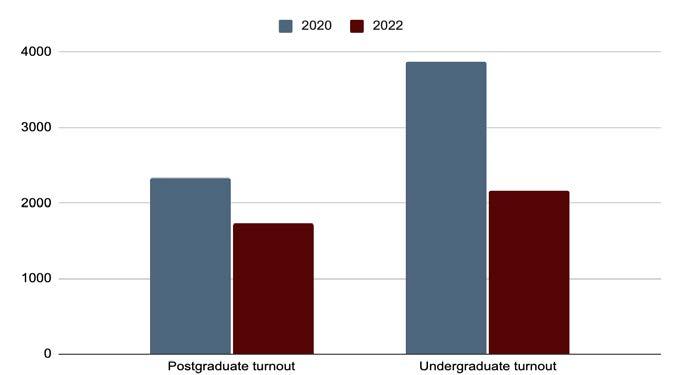
SRC elections.
Electoral regulations
Unlike the SRC and USU elections, there are no formal regulations on campaigning. Candidates are permitted to campaign as soon as the ballot is announced, although most did not begin until voting opened on 4 October. The University also does not provide any campaign funding for candidates – nor funding caps. Jorgensen’s campaign clearly took advantage of this, with Jorgensen personally funding all of his campaign materials.
Although the regulations also state that the election must be administered by way of secret ballot, the online format makes it particularly more difficult than physical ballots to guarantee that all votes are casted privately. Additionally, there are minimal directives on the email notifications and
Both Jorgensen and Shen are promising a suite of reforms in student services such as special considerations, as well as promoting diversity on campus. However, it is yet to be seen how effectively they will be able to carry out their promises given concerns about the effectiveness of student fellows in influencing University management.
Jorgensen and Shen have the most electoral experience out of the candidates within their respective ballots. Jorgensen has been involved in three consecutive SRC elections with Liberal-backed tickets and was an executive of USyd’s Conservative Club, while Shen held office as USU Honorary Treasurer from 2020 to 2021 (Panda-aligned, currently known as Penta, at time of election) and most recently as SUPRA Education Officer.
Jorgensen’s election follows a trend of Liberals holding office within the Senate, with his immediate undergraduate predecessors Gabi Stricker-Phelps and Francis Tamer both having conservative leanings.
In recent times, the student fellows of the Senate have had distant, if not hostile, relationships with other student representative organisations like the SRC and the USU, with Stricker-Phelps and Lachlan Finch contributing little to the SRC’s campaigns against 12-week semesters and 5-day simple extensions.
This year’s undergraduate Senate elections had a higher voter turnout than the SRC elections, the latter of which is renowned for being the most hotly contested and most visible of USyd’s student elections.
Although this year’s low participation rates are an anomaly for SRC elections, Honi speculates that higher turnout in the Senate elections is due to greater discussion and interest in the latter compared to previous years, as well as lower voter fatigue, given lower engagement in this year’s USU and
ballot themselves advising voters not to share their ballot with others.
In 2014 and 2016, undergraduate fellows Dalton Fogarty and Colin Whitchurch allegedly breached regulations by standing over voters and watching as they casted their votes. Indeed, there has been speculation that certain candidates in this year’s elections acted in a similar unethical manner by standing over voters as they casted their votes.
What next?
“The SRC will continue to hold the Senate to account, because as part of University management the Senate is responsible for the poor working and learning conditions at this institution,” said SRC President-elect Lia Perkins.
“The outgoing undergraduate fellow [Stricker-Phelps] has (unsurprisingly) completely failed students by not attending SRC meetings, and the newly elected fellow [Jorgensen] should attend to allow the Council to scrutinise his decisions and oppose his pro-Liberal positions,” Perkins said.
Jorgensen and Shen will hold office for a term of two years, ending in 2024.
HONI SOIT WEEK TWELVE 20224 | NEWS
RepsElect 2022: New OBs and Enviro Officer drama
Carmeli Argana, Amelia Koen, Roisin Murphy, Thomas Sargeant and Ellie Stephenson.
Another RepsElect has come and gone, with the office-bearers (OB) of the 2023 Student Representative Council (SRC) elected in a marathon seven hour meeting last Wednesday night. You can catch up on what RepsElect is and why it is held on our website.
The results
As expected, the Left bloc collected all of the paid OB roles and almost all of the spots on the SRC’s Executive.
The Vice-Presidents will be Daniel Bowron (Unity) and Rose Donnelly (NLS).
“Rose and I have big shoes to fill,” said Bowron, committing to furthering the SRC’s roles in activism, advocacy and representation.
The General Secretaries (GenSecs) will be Tiger Perkins (Switchroots — no relation to new President Lia Perkins) and Jasmine Donnelly (NLS — decidedly a relation of new Vice-President Rose Donnelly).
Tiger Perkins, who was one of the Environment Officers this year, said that GenSecs should care about “social justice”, particularly in the context of the NTEU’s ongoing strike campaign.
Donnelly promised to make the SRC more accessible to students.
The Education Officers will be Ishbel Dunsmore (Grassroots) and Yasmine Johnson (Socialist Alternative).
The Education Officer was unsuccessfully contested by Honey Christensen of Student Left Alliance and anarchist organisation Black Flag. “I know this position has been dealt away, but any serious education activist will support [Black Flag’s strategy regarding the NTEU strikes] now,” they said.
The Women’s Officers are the preselected Women’s Collective convenors, Alev Saracoglu (SLA) and Iggy Boyd (Grassroots), who were automatically voted in due to the SRC Regulations.
Saracoglu said, “The women’s collective has been one of the foremost radicalising spaces on campus.”
Boyd took aim at the “veritable three stooges” of the Liberals and joke tickets on Council, arguing that they use the tactic of joke tickets to cover over their support for misogynistic systems.
There are five General Executives, who are not paid but do sit on the SRC Executive: Emily Mackay (Engineers), Daniel O’Shea (Unity), Eliza Crossley (Switchroots), Harrison Brennan (Switchroots) and Michael Grenier (Independents Inc.).
The candidates broadly emphasised the importance of effective administration within the SRC.
Regrettably, the First Nations Officer portfolio remained unfilled at RepsElect for a second year.
The implications of recent changes to the Regulations:
A host of changes made to the SRC Regulations earlier this year had wideranging implications for how RepsElect played out.
Interestingly, where previously minor
roles involved two positions that were split between four people, they are now four discrete positions.
This raises the bar for factions to achieve a supermajority. In previous years, a two-thirds majority on Council would deliver the allied factions total control over the Council. Indeed, with the support of both Penta and the Engineers, the Left bloc this year did have a two-thirds majority. However, they did not secure all positions, because the expanded set of positions available now requires a threequarters majority to wield total control.
On some positions, Student Left Alliance voted with the Left bloc, allowing them to lock out the Liberals. However, where this did not occur the Right were still able to secure some positions, including one General Executive. It appears that Independents and the Liberals largely voted together throughout the meeting.
Another big change was the enshrining of collective autonomy for some positions, which practically meant that roles like Women’s Officer, Queer Officer and Disabilities Officer were not open to nominations so long as there were candidates preselected by the relevant collective.
Electoral Officer Riki Scanlan’s initial reading of the Regulations saw the preselected Convenor of the Autonomous Collective Against Racism (ACAR), Rand Khatib, automatically elected along with three other nominees. However, the Chair of Standing Legal, Felix Wood, overruled this reading, determining that Khatib was the only valid candidate.
Liberals try stand-up comedy (not
entreating the Left to get a job instead of striking, extolling the virtues of working in cafes if people dislike casual academic jobs so much. According to her LinkedIn, Leach has worked as an Intern at UBS and as a Researcher at the Liberal-aligned think tank Blueprint Institute.
“You guys claim to care about the working class, but you’ve taken the work out of working,” Leach said. “What the SRC needs to do is take a stance against taxation.”
Rampant inter-Trot beef
The tensions between Socialist Alternative and Solidarity reached a fever pitch when the meeting got to the election of the Environment Officers. Four candidates had been preselected by the Environment Collective: Angus Dermody (Solidarity, running for a second term), Marcus Langdale (Solidarity), Rory Larkin (Solidarity), and James Sherriff (Black Flag).
SAlt, having long been critical of collective autonomy as a concept, contested the vote, with both Maddie Clark and Simon Upitis running against the preselected convenors.
Clark described the preselection as a “sham election” to which Larkin responded: “Frankly I think it’s hilarious that members of Socialist Alternative call the Enviro Convenor Election, which had 30 activists there, a sham election.”
Honi hears the Labor factions voted with SAlt, and Switchroots did not bind, meaning their votes were likely split between the two factions.
The eventual result was the election
of the Communist Party of Australia.
This set in motion extensive denunciations from SAlt.
“We should be supporting Chinese students fighting back, we should be supporting the Iranian revolt,” Sophie Haslam said. “Skye should be expelled from your faction.”
“Grassroots, what are you doing about this!” yelled Ella Haid, with other SAlt members shouting “Shame on you!”
Grassroots headkickers eventually led Dannaher outside for a word.
Satvik Sharma and Cooper Gannon also ran for the position, continuing their attempts at comedy.
Eventually, Jasmine Al-Rawi, Deaglan Godwin, Skye Dannaher, and Satvik Sharma and Cooper Gannon were all elected, contributing to what will no doubt be a fractious year for the Global Solidarity portfolio.
The year ahead
RepsElect marks the formal conclusion of this year’s SRC election season. With the election of a brand new executive and a suite of office bearers, Honi can analyse trends in the changing balance of power between the various factions, as well as forecast issues that are likely to emerge next year.
In terms of the factional composition, Switchroots has maintained a strong position, picking up five extra OB positions in comparison to last year despite a marginal decrease in Council seats. As predicted, SAlt has made significant gains in OB positions, which is reflective of their growing presence on Council. The Labor factions NLS and Unity have seen marginal gains, picking up both Vice-President offices and one General Secretary position, with NLS winning an additional three OB positions. The Liberals have also had marginal gains, with two more OB positions than last year, including Enviro Convenor.
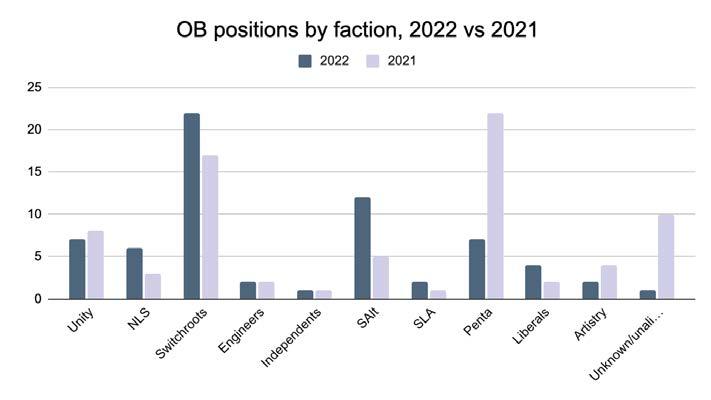
Going into 2023, the ongoing NTEU bargaining campaign is likely to crop up again as a key issue for student activist organising.
their strength)
First-year Councillor Satvik Sharma, of the Liberal joke ticket Gymbros, made a series of awkward attempts at riffs throughout the meeting, running for just about every position he could to secure more speaking time.
Sharma embarked at one point on a rather boring dramatic reading of Milton Friedman and at several points on off-key satirical renditions of ‘Solidarity Forever’.
Cooper Gannon joined in the musical fun with a slightly more tuneful rendition of ‘Hypocrisy Forever’. Gannon also launched into an extended bit about everyone on the Left growing up on the North Shore, attempting to analogise that assertion with claims from the Left that Liberals are racist and sexist.
“I’m a racist, sexist, misogynist transphobe,” Gannon concluded.
Freya Leach embarked on a bizarre rant
of both SAlt candidates, along with Larkins and Liberal Satvik Sharma. The announcement of this result caused an explosion of anger across the room, with both sides accusing the other of allowing a Liberal to be elected.
“Shame on you,” screamed SLA. “What a fucking joke!”
The ensuing furore involved WHSviolating noise levels and nearly escalated to a physical fight. Secretary to Council Julia Robins eventually intervened, threatening to shut the meeting down if the chaos did not cease.
Global solidarity: who with?
Just like in 2020, Socialist Alternative and Grassroots got into an altercation over Stalinism, after Skye Dannaher (Grassroots) started their speech for Global Solidarity Officer with a quote from Mao Zedong and identified themselves as a Marxist-Leninist. Dannaher is a member
With a new Labor government and an upcoming state election, the SRC will likely see robust debate about the position it should take in relation to the Labor party. As more details about the evasive Higher Education Accords are released, the prospect of an Indigenous Voice to Parliament referendum approaches, and various industrial action from the public sector increases, these issues are expected to be raised as motions and discussed in Council. The marginal gains from Labor factions NLS and Unity will likely factor in.
After a record low voter turnout in this year’s SRC elections, as well as the election of a number of younger Councillors and office bearers, the incoming SRC will have the unenviable task of reinvigorating campus life and student democracy. Indeed, this year’s President and Honi Soit elections were uncontested, and the SRC elections had the lowest participation amongst all three elections this year, even losing to the Senate elections. The incoming SRC will have to labour in 2023 to genuinely engage with students, especially as the gradual return to campus continues.
NEWS | 5HONI SOIT WEEK TWELVE 2022
VC charged USyd more than $10k for personal Oxford and Cambridge Club membership
claimed and approved with consideration of relevance to the role”.
Former Vice-Chancellor (VC) Michael Spence charged the University of Sydney $10,484.46 over eight years for membership fees to the exclusive Oxford and Cambridge Club in London.
Spence first charged the University for membership in 2013, and continued to do so for the remainder of his tenure, which ended in 2020.
Yearly membership to the Oxford and Cambridge Club costs £1,550 ($2,732.75) for a resident of London, or £1,033 ($1,821.24) for members residing overseas.
Exactly why Spence was allowed to charge the University for his membership fees is unclear, and seems to contravene USyd’s own expense policy. USyd policy classifies memberships to “fitness clubs, golf clubs or other bodies that are not required to carry out University business” as “personal expenses” that are not allowed to be expensed to the University.
When asked to justify Spence’s membership, a spokesperson for the University simply stated “club membership and subscriptions are
The documents released to Honi indicate the expenses were approved by then Chief Financial Officer, Mark Easson, but the specific justification for the expenses is currently unknown.
When Spence first charged the University for membership fees in 2013, he did not pay the Club’s stipulated joining fee. The absence of this fee suggests Spence was a member of the Club before he began claiming the cost against the University. In this case, Spence shifted a personal financial commitment that he was already paying onto USyd’s dime, seemingly to save himself more money at the cost of the University.
at any institution of higher education” a distinct category of ‘University Membership’ compared to regular alumni. The documents reveal that Spence’s status was a regular ‘Overseas Member’.
Spence, by the time his term ended, was raking in $1.6 million per year in salary, super and bonuses from USyd.
The Oxford and Cambridge Club’s sheer opulence makes it even more difficult to rationalise the alleged necessity of its cost to the University. Founded in 1830 and right next door to St James’ Palace, the exclusive social club is reserved for alumni of Oxford and Cambridge and is home to various politicians and royalty, including the Queen of Denmark, the Prince of Wales, and the former Duke of Edinburgh, as well as celebrities like Stephen Fry.
The Club is highly selective – to be considered for “election to membership”, a candidate must be proposed and seconded by existing members before being evaluated by a selection committee.
standard rooms equipped with “Egyptian cotton” sheets.
Universities, naturally, participate in a global process of exchange and inquiry. The pursuit of knowledge and innovation is not a national pursuit. Academic developments frequently arise from collaboration between researchers of different nationalities and from different institutions. Clearly, universities must be active global citizens and should not shy away from seeking out opportunities for international connection. Being jingoistic about knowledge production is obviously absurd.
But how do we ensure that collaboration is ethical, particularly in a context where concerns about national security within the tertiary education sector abound?
Regulation of academic research in light of fears of foreign interference is on the rise. The University Foreign Interference Taskforce was established in 2019 to safeguard against it. A parliamentary inquiry into national security risks within research concluded earlier this year. Since 2019, the USyd bureaucracy has included the Research Risk Advisory Committee (RRAC) to assist in ensuring research partners of the University align with its values and legal obligations.
In the midst of this, concerns for academic freedom are growing. Antiespionage laws could see academics in legal trouble if critical research towards Australia’s intelligence and military activities reaches foreign colleagues or international students. Attempts
The released documents also indicate Spence’s membership to the Club was in a personal capacity, rather than as a representative of the University. The Club offers those “holding appointments
The Club’s facilities include dining rooms, two bars, two squash courts, a billiard room, a library with over 20,000 books, and more than 40 five-star
Members are bound by strict dress regulations: “Gentlemen are required to wear a tailored jacket, tie and fully button-fronted shirt, fastened at the collar… Gentlemen who remove their jackets pursuant to Rule 38 must wear long-sleeved shirts fastened at the cuff… Shorts, sweatshirts, fleeces, tracksuits and t-shirts are never acceptable.”
While Spence enjoyed the luxury of the Oxford and Cambridge Club, he simultaneously presided over unprecedented austerity measures at USyd, resulting in widespread course cuts and job losses. Instead of going to perhaps the most lavish social club in the world, the $10,484.46 the University directed towards covering his membership fees might have been better spent on student welfare, paying academics properly, or even a much-needed Opal card for Belinda Hutchinson.
to prevent foreign interference could constrict academic research — for example, even anonymous survey results, which theoretically could include responses from foreign actors, could fall within the purview of national security laws. Foreign interference laws directly bring universities and their research approval processes into contact with Australian defence and intelligence institutions like ASIO — see the Foreign Interference Bill 2020, for example.
So, academics are subject to increasing impositions — in some cases, direct oversight — on their research activities. Where is University management in all this?
Ministry of Education. Similarly, in 2020, Spence zoomed with the Indian High Commissioner to discuss India’s national education policy. Upon his ascension to the Vice-Chancellorship, Mark Scott participated in meet-and-greets with both the Chinese and Indian consulates, which tracks with the nations’ importance in Australia’s education sector. There are also a variety of cultural meetings: Chinese New Year celebrations in 2019, a meeting with the Duke and Duchess of Sussex Harry and Meghan in 2018, assorted dinners with diplomats.
A University spokesperson told Honi: “University leadership often meet external visitors or officials in order to promote the University’s capacity for research and teaching to generate leads for potential partnerships – including some that can contribute to national, regional and global security.”
that were discussed, but told Honi that the University seeks collaboration “in line with all relevant Australian laws and government guidelines, and with the University’s objectives, values and policies.”
Our interest piqued by former ViceChancellor Michael Spence’s expenses for a ‘Chinese navy function’, Honi requested information on all meetings between senior management and foreign government or military officials between 2018 and the present. A total of 45 meetings were disclosed to us, with the bulk of those involving either the Vice-Chancellor or the Deputy ViceChancellor (Research).
The majority of these appeared to be fairly anodyne relationship-building with some of the largest sources of USyd’s international student population – 22 of the 45 meetings were with representatives of China. Some of those were with delegates from the Chinese
The University’s international engagement doesn’t stop there. University managers met on a number of occasions with foreign military officials. The aforementioned Chinese Navy Function remains unexplained, along with a number of meetings with United States military organisations.
In July, Scott met with officials from the US Department of Defense to discuss “research collaboration opportunities”. In May, Deputy Vice-Chancellor (Education) Duncan Ivison met with a delegation from the US Office of Secretary for Defense (OSD) and Australia’s Defence Science and Technology Group (DSTG).
The University did not comment on the specific research opportunities
These meetings raise questions about USyd’s involvement in defence research. While Australia’s national security laws are stringent, they apply where there is tension between research and strategic goals, but it is less clear how we can ensure transparency when we are collaborating with our allies. Interestingly, the University explicitly prohibits collaboration with tobacco companies, but makes no comparative exclusions for other potentially ethically problematic activities.
Academics have suggested that strengthening our institutions is crucial to navigating the complexities of international ties and military research. NTEU Vice-President (Academic) and lecturer in modern Chinese history David Brophy argues in his book China Panic that so many of the threats of national interference stem from the erosion of the core of the University. Where universities are properly funded and democratically run, the risks of making unacceptable trade-offs will be lessened.
6 | INVESTIGATION HONI SOIT WEEK TWELVE 2022
Amid national security focus, USyd management meets with foreign military officials
“Spence seemingly shifted a personal expense that he was already paying onto USyd’s dime.”
“Spence, by the time his term ended, was raking in $1.6 million per year from USyd.”
Fabian Robertson investigates.
Ellie Stephenson investigates.
“Michael Spence expensed USyd for a ‘Chinese Navy Function’.”
“Meetings were held with the US Department of Defense, US Office of Secretary for Defense and Australia’s Defence Science and Technology Group.”
Inside Villawood detention: where racist guards abuse, smuggle drugs and use detainees for sex
Joey was just three months old when he landed on Australian soil for the first time in 1975. The young family –consisting of Joey, his parents, sister and two brothers – left Tonga for the land of opportunity, at a time when Gough Whitlam’s Labor Government had recently implemented sweeping immigration reforms.
By this point, the racist White Australia Policy had effectively been dismantled, and the long-overdue Racial Discrimination Act 1975 had just been passed. Migrants faced fewer barriers to entry due to the colour of their skin, and the foundations for Australia’s multicultural society were well and truly established.
“Like any other migrant,” says Joey, “we came for a better life.”
When Joey’s family first set foot on Australian soil in 1975, they did so with optimism, with hope. They simply could not have begun to imagine that, 48 years later, their son would be sitting in a cell, detained without conviction, and facing deportation to a country he hadn’t visited since he was a child.
Today, Joey speaks to me from his cell in Melbourne Immigration Transit Accommodation (MITA), where he has been locked up for the last 18 months.
“It’s worse than prison in here,” he says. “This place is designed to break you.”
A little more than 650 kilometres away, deep in the heart of Western Sydney, sits Villawood Immigration Detention Centre – Australia’s most populated detention centre, with 498 detainees.
Ahmed* spent four years and eight months inside Villawood – an experience he says changed him irreversibly, even five years after his release. Ahmed fled armed conflict in Sudan in 2012, arriving at Sydney Airport in June that year. From there, he was immediately transferred by the Australian Border Force to Villawood.

HONI SOIT WEEK TWELVE 2022 FEATURE | 7
Fabian
Robertson Content Warning: Suicide and sexual abuse.
“It’s worse than prison in here. This place is designed to break you.”
Ahmed’s voice begins to waver slightly when I ask him about life inside the detention centre.
“It’s inhumane – a terrible, terrible place. I never thought Australia could be like this,” he says.
They’re using you and taking advantage of you.
“Male guards will abuse their power to have ‘relationships’ with female detainees. The poor girls might think they’re in love with the guards, but the guards are just using them.”
those offered in prison.
“In prison, any medical issue you have is addressed. You have doctors, psychologists, and you get counselling support. You have a whole program dedicated to Christian ministry and support groups.”
By contrast, those in MITA are largely left to fend for themselves. In the 18 months he has spent in custody, Joey has witnessed the mental degradation of countless detainees.
Ahmed is vague at first, hesitant to reveal specific details due to fear of being identified. Ahmed suffers from extreme anxiety that developed during his time in Villawood – perhaps this explains his cautiousness. Only when I reiterate that he will remain anonymous does Ahmed begin to speak more freely, until it all comes out in a feverish stream of consciousness, as if the words are escaping from his lips for the first time.
“The guards, they hate refugees and they enjoy punishing you. They treat you like animals.
“They clearly tell you that you are just a number, not a human,” he says.
In addition to taking advantage of detainees for sex, Ahmed claims that Serco guards smuggle drugs into Villawood.
“It’s worse than on the street; you can get any drug you want,” he says.
Ahmed’s experiences corroborate the findings of a report by The Guardian, which estimates that $10,000 of drugs –including methamphetamine, heroin and cocaine – are smuggled and sold inside Villawood every week.
For Ahmed, Serco guards have blood on their hands.
“Do you know how many people kill themselves? How many people they mentally torture?”
There were 194 reported incidents of self harm across Australia’s onshore detention centres in 2021, with 67 occurring at Villawood and 42 occurring at MITA.
“There’s a lot of broken people in here. Some of them are – and I hate to use the word – but they’re zombies. This joint has destroyed them,” he says.
One particular incident stands out to Joey as a damning example of the lack of care exercised by detention centre staff. Joey had been in MITA for just four months when a man attempted to commit suicide in front of him.
The man, an African refugee whose visa had been terminated by the Australian government, tried to hang himself with a bedsheet in the detention centre’s laundry room. The man had constructed a noose out of the sheet and was in the process of hoisting it to the ceiling when Joey walked in.
Joey managed to talk him out of it.
“I told him that no good would come of it, for him and for his family,” Joey says.
Beyond mental health services, the overall living conditions in detention are, in some ways, much worse than those in prison. Prisoners in Australia generally get their own cell, but in immigration detention, there are a minimum of two detainees per room, and sometimes up to four. In instances of overcrowding, detainees are sometimes made to sleep on mattresses in common areas for extended periods of time.


“When you share a cell with another detainee, your space is immediately halved,” says Joey.
According to Joey, the impact of another cellmate is exacerbated by a lack of available cleaning products.
The guards Ahmed is referring to are employees of private contractor Serco. In conjunction with the Australian Border Force, both Villawood and MITA are run by Serco as part of their multibilliondollar contract with the Australian government to manage on- and offshore detention centres.
“When they want to be violent, the guards just turn the security cameras off. They jump on you—six or seven guards at once—they jump on you.
“Then, after, they say self-defence,” says Ahmed.
Ahmed describes one incident where a detainee was attacked by several guards, two of whom pinned him to the ground, with his arm forcibly held behind his back and his face against the concrete. The detainee yelled out in pain, pleading with them to stop because he thought his arm was broken. The guards took no notice, and a Serco manager responded to the detainee, “don’t worry mate, we’ll fix your arm for you.”
Ahmed explains that guards discriminate against detainees on the basis of their race – a clear contravention of Serco’s contract with the Australian government.
“Islander guards look after their own Islander boys, Lebanese guards look after Lebanese boys. There’s not a lot of African guards, so of course, Africans are going to be the victims,” says Ahmed.
Ahmed also alleges that guards engage in sexual relationships with detainees.
“The guards, they use their power to have sex with refugees. They’re not forcing you, but they’re giving you hope.
The high rates of self harm in detention centres are unsurprising to Joey, who also reports violence, racial discrimination, drug smuggling, and sexual abuse on the part of Serco guards.
“I’ve been told that sex happens between male guards and female detainees, and that guards bring drugs in for them in return,” he says.
“I’ve been told by women that they’ve been sexually abused by guards.”
Even in so-called ‘consensual’ relationships, the capacity for a detainee to consent in such a dynamic has been questioned in psychological studies, as the inherent power imbalance in the lends itself to coercion.
“In other instances, when the guards don’t get what they want, they threaten to send you to Christmas Island, to make life difficult for you,” Joey says.
For Joey, mistreatment by guards – most of whom are “bullies” – is just one factor contributing to poor mental health in detention. Indeed, Joey believes that mental health services in MITA are simply inadequate, and far worse than
Joey immediately reported the incident to staff, who were unresponsive.
“They told me: ‘Fill out this form and someone from the mental health department will address the issue in three or four days’.
“If you’re going to kill yourself, you can’t wait three days,” says Joey.
Less than a week later, that same man climbed on top of the laundry building’s roof and threatened to jump off and break his neck. After a long standoff, the police were called, and the man has since been placed on sedative medication administered by depot injection.
“In prison, it’s easy to keep your cell spotless. Here, it’s very hard to keep your cell and yourself clean – you just don’t get those cleaning utilities here,” he says.
In comparison to detention, prison places far greater emphasis on rehabilitation. In prisons across Australia, inmates can complete educational and vocational training courses with realworld applications to be used upon their release, such as hospitality and trades courses.
By contrast, such courses in immigration detention explicitly come without formal qualification, meaning they are not officially recognised and have limited application in Australian society.
“Now he walks around lifelessly, his mouth open and drool coming out,” says Joey.
“In prison you can do courses that will help you. Here, at the bottom of the certificate it says this certificate cannot
8 | FEATURE HONI SOIT WEEK TWELVE 2022
Ahmed’s voice begins to waver slightly when I ask him about life inside the detention centre.
“The guards treat you like animals. They clearly tell you that you are just a number, not a human.”
“A man tried to hang himself in front of me. I reported it to staff, who told me they would follow up in three days after I filled out a form.”
be used outside. So what’s the point? You’re just wasting your money,” Joey says.
While approximately 80 per cent of Australian prisons are publicly-run, immigration detention centres are almost entirely operated by private companies like Serco. This has not always been the case. It was only in 1998 that John Howard’s Liberal-National government made the switch from publicly-run immigration systems to
and actively participating in Ministry services, as well as running counselling sessions for fellow inmates.
“In a way, the eight years in prison saved my life. I’m not the person I was 10 years ago,” he says.
Today, Joey uses Zoom to give talks about faith, rehabilitation, and youth justice in drug rehab centres, high schools, and youth groups.
Joey was born in Tonga, meaning he
additional funding from the Australian government. If Joey’s appeal to the High Court is unsuccessful then, his detention in MITA remains indefinite, along with hundreds of other detainees who cannot be deported to their country of origin.
Having served the full extent of his 8-year prison sentence and now having spent 18 months in MITA, Joey feels that 501s are subject to “double jeopardy”.
“I’ve served my time. I’ve paid my debt to society. Now it feels like I’ve been handed a life sentence,” Joey says.
The current policy of mandatory visa cancellation was legislated by Tony Abbot’s Liberal-National government in December 2014, causing a spike in cancellations from 76 in 2013-14 to 1,278 in 2016-17.
on an anklet where I’m monitored.
“I just want to return to my children, my grandchildren, and contribute to society,” he says.
After speaking with Joey for some time, I ask him if he still has hope for the future.
“Under the Liberals, there was no hope. But now, under Labor, there is.
“Anthony Albanese did say that no one will be left behind. He said he will clear out all the backlog of people that have been here for 10 years or more. I mean, it came out of his own mouth,” he says.
privatisation, likely with the intention of cutting costs and improving efficiency. Today, immigration detention costs the Australian public a monumental $428,542 per year per detainee, while conditions inside continue to worsen.
A 2017 United Nations report concluded that outsourcing immigration detention to private companies carries great risk of human rights violations. The report found that the profit-making incentives of private companies override considerations of human rights, as detainees have their rights infringed upon with little oversight, resulting in effective impunity.
Companies like Serco have limited commercial incentive to create liveable conditions for detainees and promote rehabilitation. Rather, shareholder pressures and obvious profit-making incentives inevitably encourage costcutting at the expense of adequate care.
An analysis of the Serco-run Kilmarnock prison in Scotland studied the impact of cost-saving measures. Here, researchers observed that staff shortages, inadequate training, and a reduction in recreational and vocational services for detainees were associated with increased instances of violence and suicide.
At MITA, Joey reports that staff make no efforts to prevent violence between detainees, which occurs frequently. Just weeks ago at MITA, two detainees who were previously involved in a violent altercation were placed by staff in the same unit. Naturally, another fight broke out.
According to Joey, a managing Border Force staff member at MITA told him: “I don’t care if you guys kill each other, just don’t touch my staff.”
“That would never, ever happen in prison,” Joey says.
Joey’s knowledge of prison comes from an eight-year stint following a robbery conviction. Speaking to Joey on the phone, you would never expect that he had ever faced criminal charges, let alone committed violence.
Joey’s voice is heavy with empathy for the suffering detainees around him. For Joey, his time in prison completely changed his outlook on life, and he considers himself completely rehabilitated. It was in prison that Joey started practising Christianity
retained his Tongan citizenship upon migrating to Australia when he was just three months old. Joey lived in Australia on a permanent residency visa for 41 years, but his visa was cancelled in 2016 following his criminal conviction by then-Minister for Immigration Scott Morrison.
Section 501 of the Migration Act 1958 mandates visa cancellations for noncitizens who are sentenced to more than 12 months in prison. It also provides the Minister for Immigration the discretion to cancel the visas of non-citizens who fail a “character test”, in which regard can be had to less serious criminal conduct and even non-criminal “general conduct”. Individuals who have had their visas cancelled under this section are colloquially referred to as 501s.
Typically, non-citizens who are denied the right to a visa are deported to their country of citizenship. Today, Joey awaits the outcome of a High Court appeal against his visa cancellation to see whether or not he will face deportation to Tonga – a place where he has no ties, no family, and has not visited since he was a child.
If Joey’s family had migrated to Australia three months earlier, he would have automatically acquired Australian citizenship when he turned 10, and today would be out in the community, living as a free man. Instead, the three months Joey lived in Tonga as an infant have condemned him to detention in MITA for the foreseeable future.
Yet just last week, Joey informed me that members of the Tongan embassy have indicated their government will accept no further deportees without
According to Joey, many 501s in MITA had their visas cancelled on the discretion of the Immigration Minister following non-serious criminal offences, such as traffic offences or receiving stolen property.
“The idea that only people who spend more than 12 months in jail have their visa cancelled is garbage.
“There are people in here who had their visas cancelled after a few months in prison, and now face being locked up for years.
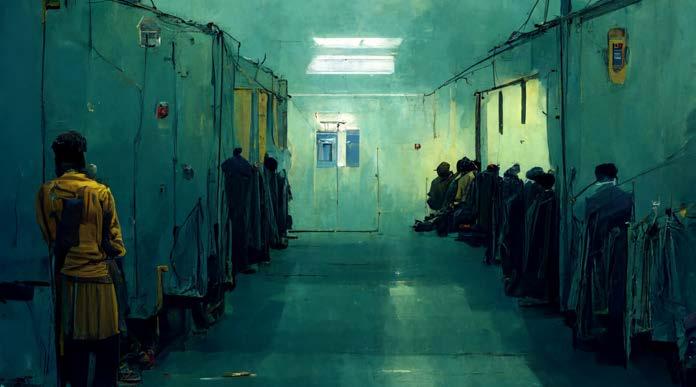
“501s are human beings like everyone else, but to the government, our lives are worth less. We’re treated like trash.
“Every week when he was in opposition, there were detainees from MITA in contact with Albanese’s office, and they were saying ‘Look, if he gets in, he’s definitely looking at changing the legislation’”.
Five months on from the election and changes to the Migration Act have not been discussed.
“The biggest thing I ask is for Albanese to please act – not just for 501s, but for refugees.
“We need to act as soon as possible to stop the deaths in custody here,” says Joey.
“Australians are quick to criticise other countries for human rights abuses. We’re quick to criticise countries like China, Afghanistan and Iran. But it’s happening right here, in our own backyards,” Joey says.
Joey has 11 children and three grandchildren living in Australia who he is not able to see outside of strict visitation hours. He is yet to meet one of his grandchildren.
“We’ve all made mistakes, but all we ask for is one chance. Let us get back to society,” Joey says.
“I’m happy to sign on in the police station every day. I would be happy to put
“It’s hard for my kids. I’ve had many phone calls with them where they’ve said, ‘Dad, do you think you’ll go? We need you here.’
“All I can say to them is that ‘Sometimes in life there are things that are out of your control.’
“I tell them to ‘Work hard and live a good and righteous life, and to make sure to help people as much as you can’.
What else can I do?”
Today, there are 1,398 people held in immigration detention in Australia, and 501s make up 855 of them. A further 203 are held in an offshore Serco-run facility on Christmas Island.
As of 30 June this year, the average period of time that people spend in immigration detention in Australia is a record high of 742 days.
A total of 144 people currently detained have spent more than five years in detention.
The average period of immigration detention in Canada, UK, and US is 24, 29, and 43 days respectively.
HONI SOIT WEEK TWELVE 2022 FEATURE |9
Border Force told Joey: “I don’t care if you guys kill each other, just don’t touch my staff.”
“I just want to return to my children, my grandchildren, and contribute to society.”
“Albanese did say that no one will be left behind... We need to act as soon as possible to stop the deaths in custody here.”
If you’re a third or fourth year USyd student, you’ve probably encountered the Industry and Community Project Unit (ICPU).
Introduced in 2018, 3000-level ICPUs engage students across a range of faculties in semester-long project work with an industry partner. According to their unit overview, ICPUs allow students to “cross disciplinary boundaries”, address “complex” “real-world” problems, and emerge newly pragmatic and employable.
When I commenced my compulsory ICPU this semester, I did so begrudgingly: I was wary of participating in an opaque, corporate exercise informed by one-sizefits-all notions of employability and a deeply unedifying academic approach. The total intellectual vacancy of my interdisciplinary impact unit last year only exacerbated my pessimism.
Interdisciplinarity & building the job-ready graduate
At USyd, the term ‘interdisciplinary’ peppers undergraduate handbooks and promotional material, coalescing with other empty buzzwords like ‘flexible’, ‘dynamic’, and ‘employable’ to describe its graduates.
At first glance, interdisciplinarity is a benign, progressive academic ethos, facilitating enriching exchange between typically siloed areas of study. It only makes sense that fields like environmental science serve to benefit from osmosis with the humanities, and vice versa. In fact, many degrees are naturally quite interdisciplinary.
Within a context of extensive austerity measures, however, the University’s appropriation of ‘interdisciplinarity’ is justifiably suspicious.
Indeed, Honi has previously criticised the new interdisciplinarity movement in higher education, contextualising it within pernicious university corporatisation and the degradation of education standards. At USyd, interdisciplinarity’s place in a culture of opacity and mistreatment of staff is exemplified by FASS’ abolition of historical and respected departments in favour of a disciplinary structure earlier this year, further diminishing academics’ autonomy.
The students I surveyed described mostly negative experiences of ICPUs as interdisciplinary learning environments. Students were not dissatisfied with the concept of interdisciplinary study itself, but the University’s failure to meaningfully facilitate it.
“[The ICPU] just made my brain feel like it was being sapped,” says Amy*, an English student who completed her unit with NSW Environment and Planning in late 2020.
“It didn’t make me feel job ready or anything like that. It just made me feel useless [...] I was having to really dumb down [English] concepts and make generalisations.”
Amy negates the extent to which ICPUs facilitate truly ‘interdisciplinary’ work,
explaining how she was placed in a group composed entirely of VET and science students for her project ‘Saving Koalas’.
“It wasn’t really interdisciplinary… I was trying to bring in these eco-critical ideas, and talk about colonialism and the environment, but because I was the only humanities student in the group, it was so science focused.”
Across industry partners, ICPUs follow a pretty uniform structure, requiring students to select a shell unit (e.g. ‘ENGL3998’ for English), and choose a partner project from a list prior to commencing the semester. They are briefed by the partner in their first week, and must undertake a structured problem-solving process in groups to produce a businessstyle report. Throughout, students must reflect on how their individual discipline affected their work.
Mark*, a fourth year Science/Advanced Studies student who worked with TAL Life Insurance, felt ICPUs did not meaningfully teach interdisciplinarity.
“I just don’t think forcing interdisciplinarity down people’s throats really works,” he says.
“All of the actual uni staff were great and helpful… [but] I don’t think it’s something that you can set four weeks of reading on, and expect that to sink in or to actually do anything,” he says.
He mentions that his handbook made it very unclear whether the subject was necessary for course completion. In fact, only Advanced Studies students with two FASS majors must undertake an ICPU. For FASS students with just a single major, or a second major outside of FASS, ICPUs are one of two interdisciplinary unit options. For the faculties of Architecture, Design and Planning, Law, Business, Engineering, Medicine and Health, and the Conservatorium, ICPUs are also optional.
This is somewhat confounding, considering that ICPU project partners and topics are most catered to some of these disciplines.
According to a University spokesperson, “partners are selected to provide students with a selection of corporate, industry and government organisations with appeal to a wide range of students/disciplines.”
However, of the 15 partners on offer for Semester 1, 2022, 10 are banks, insurance companies, tech companies, or the University itself. For Semester 2, that number is 13 out of 17. Dominated by the topics of AI, data security, and digital infrastructure, there are few academicallyaccessible project options for arts and humanities students.
Eve* is an International Relations student who completed her ICPU with ANZ last year.
“I couldn’t tell you what we were trying to solve,” she says. “I wasn’t even interested in it.”
“I think [the skills you learn are] really quite niche. It literally has not crossed my mind until this very moment to go into a job interview and be like, ‘in fact, I did this [unit].”
Alana*, who worked with Westpac, is one student for whom ICPUs have been useful
in her career. She enrolled in an optional unit for her Marketing major to “beef up her resume” for internship applications. She finds the problem solving, analysis, and presentation skills imparted by her ICPU useful in her current consultancy position. But, like other interviewees, she disagrees with mandating ICPUs for some students.
While Eve and Alana expressed positive group work experiences, most interviewees felt unable to fully engage their disciplines and interests in their projects. Like myself, Amy noticed that ICPUs’ prioritisation of ‘pragmatism’ and ‘actionability’ devalues the modes of critical engagement taught in the arts and humanities.
“[The mindset] was completely like, ‘no, this is just unrealistic for a government project.’ I couldn’t bring any ideas I actually cared about to it because it was [meant to be] a ‘pragmatic approach’” she says.
Amy and Mark both note that interdisciplinary naturally exists in their coursework, and need not be artificially spoon-fed to students.
“We do interdisciplinary stuff in English all the time,” says Amy. “It’s so much more useful to let us do elective space in another subject.. [as] a way of exploring how another discipline works compared to your own.”
“With most of the people you work with [in your degree]... there’s loads of double degrees,” adds Mark. “People are [always] bringing frameworks from all the different disciplines and faculties across the University.”
Despite grand promises of employability, ‘interdisciplinarity’ has proved itself a suitably-vague buzzword in which the University may couch arguments for greater degree generalisation and less truly interdisciplinary elective study for many students.
Intellectual property & project partners
In asking students to complete free labour for major corporations, ICPUs engender concerns about students’ intellectual property.
All students must sign a Deed Poll at the commencement of an ICPU, a requirement disclosed in fine print on the how-to-enrol information page. A deed poll is a legal document binding a person or several persons to express an intention, or create an obligation. It is a ‘deed’ because it only binds one party. As Honi reported earlier this year, it is basically a Non Disclosure Agreement in all but name.
“How can there be informed consent around a deed poll when it’s a compulsory part of your degree?” says Amy. “There are no ethics behind that.”
The ICPU deed poll licences students’ intellectual property to the University, who may then licence it to the industry partner. It also swears students to keep material about the industry partner and University confidential without written consent.
“[The deed poll] did not sit well with me,” says Eve. “I knew the chance of them actually taking any of our work and implementing it was really, really slim, but it was just the principle of it.”
Despite ICPUs’ employability-centric marketing, it is unclear how the units will benefit graduates given their stringent confidentiality requirements.
Of course, one might argue that many students are used to performing free labour as an investment towards future employment.
Alana, who describes “going around doing unpaid internships” in her first year, says that “doing [industry work] in a HECS-ed setting, where I can just pay my fees later, was much better than the alternative.”
Conversely, Mark, Amy, and Eve all expressed discomfort and frustration towards being forced to work with big corporations, even where the project initially interested them.
Mark’s TAL Life Insurance project, ‘Protecting the Gig Economy Workforce’, was advertised as “protecting gig economy workers and a great social justice initiative,” he says. “In reality it was just like an advertising scheme.
“It was like we were being used as consultants to help TAL make money off the economy workers who already don’t have disposable income to spend on life insurance.
“I wanted to look at legislation and policy surrounding gig economy workers and I was immediately told like, that’s not what we’re doing here.”
As a result of this reductive framework, he says most of the final projects were trivial apps that didn’t deal with the problem of gig economy workers not “getting paid a livable and standard wage.”
Improvements
ICPUs dispense limited academic benefit or enjoyment to students, yet the University defends them while many other units are cut. With its billion dollar surplus, it’s surely no stretch of management’s finances or imagination to overhaul ICPUs, and release the structural grip of disciplinarity in faculties like FASS.
When asked what they would change about ICPUs, all students wanted more transparency and communication between students, the University, and industry. Amy, Mark, and Eve think that interdisciplinary industry work could benefit students, but not in its current form. Mark and Amy both desire “more freedom” to explore their interests and better project options for arts students.
“Honestly, I just think that it’s like a terribly flawed idea from the get-go,” says Amy.
“If my degree isn’t gonna directly land me into a job, that’s just the reality for when you choose English.”
If the University wants to promote truly enriching interdisciplinarity, students should have more options to do more units from a wide range of faculties. It should focus on building students’ own specialised knowledge and skills. Its relationship with students should be based on honesty, integrity, and equal value for all degrees and students.
Though, knowing this University, we might not want to get our hopes up.
HONI SOIT WEEK TWELVE 202210 | UNIVERSITY
Zara Zadro talks to students about USyd’s infamous Industry and Community Project Units.
Walking past the golden sandstone of Sydney Medical School’s Anderson Stuart Building and into its entrance, an imposing marble bust of the School’s founder, Thomas Peter Anderson Stuart (1856-1920), greets students. The bust of the building’s namesake rests alongside his carved initials, coat of arms, and a famous raven. USyd’s commemorative display does not reflect Anderson’s dark history as an enthusiastic believer in eugenics and a White Australia. Nor is founding Professor of Preventative Medicine Harvey Sutton (1882-1963), who had a scholarship named after him in the School of Public Health, remembered for his role in propagating eugenics and medical racism.
Anderson Stuart: racism and eugenics
Anderson Stuart was a member of the Eugenics Education Society in New South Wales and took an active part in the Society’s activities, paying a personal tribute to eugenicist Francis Galton in a lavish dinner hosted by the Society.
Then, In 1912, Stuart was the University of Sydney’s delegate to the inaugural International Eugenics Congress located in modern day Imperial College London, alongside fellow Australians Andrew Kirkpatrick and former Premier of South Australia John Cockburn. Here, notable delegates ranging from Charles Darwin’s son Leonard Darwin and former British Prime Minister Arthur Balfour gathered to discuss topics such as: “The Causes of the inferiority of physical and mental characters in the Lower Social Classes”, “The Bearing of Neo-Malthusianism upon Race Hygiene” and “Ethnic Psychology and the Science of Eugenics”.
Not only was the founder of USyd’s Medical School a eugenicist, he also took a leading role in Australia’s white supremacist policies, presiding overf the Immigration League of Australia between roughly 1908 and 1911. The organisation, founded by Richard Arthur, explicitly advocated for the immigration of White Europeans to Australia to deter the threat of “alien race[s]”.
During his term as President of the
Immigration League, the West Gippsland Gazette reported that Stuart advocated for stopping immigration of non-white communities, specifically those of Asian descent, to the Northern Territory.
“The policy of a ‘White Australia’ demands that this huge territory [The Northern Territory] shall not be allowed to be peopled by Asiatics. Now this question of a ‘White Australia’ is not merely of local interest. It is of imperial importance,” Stuart said.
“The Northern Territory of Australia ineffectively occupied is therefore a standing menace to the Empire. From this it is clear that the possibility of having a real ‘White Australia’ is of intense imperial interest.”
fascist Italy and Nazi Germany”. Speaking to Honi, USyd’s Professor of Politics, Governance and Ethics Warwick Anderson said that Sutton was part of a generation of Melbourne University-based white nationalists.
“Melbourne was the centre of white nationalism in the [Australian] universities,” Anderson explains, with the context that Melbourne was the nation’s former capital before Canberra’s creation. “The University [of Melbourne] was utterly dedicated to this idea of implanting a pure white race.”
In Anderson’s The Cultivation of Whiteness: science, health and racial destiny, Sutton — himself a Melbourne medical graduate — advocated for the sterilisation of those he deemed “unfit” for society: “As
the ‘unfit’ in order to improve progressively the ‘inherited worth’ of human beings.”
Assessing Stuart and Sutton’s legacy at Sydney University
In many ways, Stuart and Sutton’s records point towards a grim past for the medical profession: Australia’s early public health architecture was deeply influenced by eugenics and ‘scientific’ racism.
In a biographical entry in the Australian National University’s (ANU) Australian Dictionary of Biography, despite purporting to be “Australia’s preeminent dictionary of national biography”, any mentions of Stuart’s ties to Australia’s eugenics movement are ignored altogether.
When asked if Sydney University would consider carrying out an investigation into the pair’s legacy or updating its plaque for Anderson Stuart, the University acknowledged in a statement that Stuart and Sutton’s records are contrary to its values: “We know there are aspects of our past that are open to criticism and debate.”
Historian Dr Diana Wyndham’s Eugenics in Australia: Striving for National Fitness details that Stuart belonged to a “medical” group of Australian eugenists, who believed that eugenics could “reduce disease and suffering”. Throughout his professorship at Sydney, public addresses and correspondence, Stuart was a man deeply interested in eugenics and furthering its cause.
In British eugenicist Francis Galton’s own words, eugenics refers to “the study of agencies under social control that may improve or impair the racial qualities of future generations either physically or mentally”.
In his book, Inquiries into Human Faculty and its Development (1883), Galton coined the term ‘eugenics’: “The most merciful form of what I ventured to call “eugenics” would consist in watching for the indications of superior strains or races, and in so favouring them that their progeny shall outnumber and gradually replace that of the old one”. In other words, eugenics advocated for selective breeding, and was the ideological driving force behind much of the Australian medical profession and political class’ support of the White Australia Policy and the Stolen Generations.
Stuart admired Galton’s work, a letter written by Stuart to Galton saw him congratulating Galton on the his launch of the Anthropometric Laboratory following 1884 and expressing a desire to replicate Galton’s plans in Sydney. Stuart’s involvement in the eugenics movement, as such, was not a passing or fleeting interest.
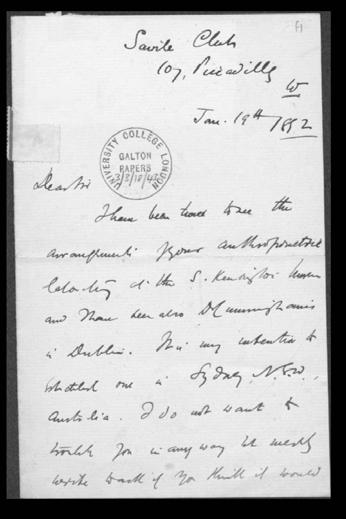
Galton’s Anthropometric Laboratory was established in 1884, whereby visitors paid a fee to be measured on a number of physical characteristics and provided a copy of their personal data.
Harvey Sutton and Melbourne racism
In many ways, Harvey Sutton, USyd’s first Professor of Preventative Medicine and inaugural director of the School of Public Health, held far more fascist views than Anderson Stuart. Indeed, Dr Diana Wyndham noted that Sutton was never shy about his “open support of regimes in
a member of various eugenics societies and the Family Planning Association, he [Sutton] sought to discourage the breeding of the physically unfit and feeble-minded, and he recommended sterilisation for hopeless degenerates.”
To pursue this, Sutton led a scheme prior to World War I whereby all Victorian schoolchildren at the time had “their [physical] dimensions and intelligence quotients” taken in part to evaluate the racial purity of White Australia.
Then, once he assumed leadership of the Commonwealth Institute of Tropical Medicine — today part of USyd’s School of Public Health, Sutton “recommended a classification of children by “racial stream”, indicating the degree of Australianness”. Sutton’s overarching goal was to create “a future white body “fully trained, free from defects of posture, upright, elastic, vigorous”.
Mirroring Stuart’s leadership of the Immigration League, Sutton was a founding member of Australia’s Racial Hygiene Association. Rodwell detailed Sutton’s indifferent attitude to colonial violence that Indigenous communities endured, “Aboriginal people formed a dysgenic Australian social group which Sutton perceived to be incurable.”
According to former USyd Professor of Physiology John Carmody in a Royal Society lecture, later on in 1925, Sutton, in his capacity as Principal Medical Officer of the NSW Department of Education, supported pre-marital health checks as a means to screen out “hereditary defectives, mental defectives and epileptics” and that this “would be a step in the right direction”. These views are even more radical than those of Anderson Stuart, who opposed pre-marital checks in 1914 on the grounds that the measures were far too complex.
Sutton’s views, in Professor Grant Rodwell’s essay, persisted even after World War II and the horrors of Nazi Germany’s fascism.
“He preached the virtues of preventive eugenics — namely segregation — as the only solution to ‘these social misfits’,” Rodwell said in the study. “Despite the legal position of eugenic sterilisation he argued for the compulsory sterilisation of
“Certainly, the views as presented are in stark contrast to our current values and policies.”
However, the University stopped short of confirming whether any investigation or update of Anderson Stuart’s plaque inside his namesake building will be carried out to acknowledge Stuart’s eugenicism or white supremacy.
“We believe it is better to work to understand our history rather than erase it and we welcome our students expressing their political opinions in a respectful manner.”
However, members of the medical profession have voiced intense discomfort with the Medical School’s ties to eugenics and institutional racism. One example is Professor John Carmody’s lecture to the Royal Society of NSW (Southern Highlands) in Mittagong, where he voiced profound unease with Australian medicine’s eugenicist connections.
“Education can lay a veneer over our emotions, but it is extraordinarily thin,” Professor John Carmody reflected.
“I suspect that it is only a matter of time before a few Australian universities are similarly compelled to establish comparable official investigations. And perhaps universities elsewhere as well (as a number in Britain and the USA have already done).”
Carmody’s words echoes the increasing momentum behind investigations into other medical schools’ own colonial exploitation. In 2020, University College London (UCL), following an investigation into Francis Galton’s legacy, renamed three buildings: the former Galton Lecture Theatre, Pearson Building and Pearson Lecture Theatre, in recognition of Galton and Karl Pearson — the former greatly admired by both Stuart and Sutton.
Carmody’s reflections offer a sombering chance for Australia’s universities to gaze into their own past. Time is overdue for Sydney University, above all its executives, to look more carefully into the dark history behind its own ties to eugenics, the ideals of White Australia and the intergenerational trauma that it causes.
UNIVERSITY | 11HONI SOIT WEEK TWELVE 2022
Correspondence between Professor Anderson Stuart and Francis Galton,
19
January
1885.
“Not only was the founder of USyd’s Medical School a eugenicist, he also took a leading role in Australia’s white supremacist policies.”
Khanh Tran checks the records of Sydney’s ties to eugenics and medical racism.
Due to be implemented across three 3-year periods, the University’s 2032 Strategy makes a number of promises to be delivered “with energy and urgency”.
Featuring bold claims and ambitious goals, the plan is driven by affirmations such as “our studentfocused education is transformational” and “our research is excellent (...) and contributes to the common good”.
While the University touts its 2032 Strategy as the realisation of its mission to maintain its position as a leading educational institute, students raise serious concerns around the plan’s impact on culturally-diverse areas or disadvantaged communities, as well as its viability.
WESTERN SYDNEY EXPANSION
Perhaps chief among the university’s deliverables is an expansion of USyd’s “educational offerings” in Western Sydney. The 2032 Strategy notes “Sydney’s centre of gravity is shifting west”. As a key strategic priority of the University, expansion to the Western Suburbs is given considerable attention in the first 3-year plan.
The University sets out to consolidate its existing presence in Parramatta/Westmead through its ‘Central River City’ expansion – including a consolidation of its existing land holdings in the Cumberland area and Camden –encompassing Mt Hunter Farm to the south and Badgerys Creek to the north.
If the destruction of heritage and community in the Camperdown/ Darlington and Redfern areas are any indication of the impact of USyd’s presence in historically diverse communities, concerns about the effects of gentrification on the rich cultural communities in the Western Sydney region are very real and valid.
SUPPORTING DISADVANTAGED STUDENTS
As the uni lags significantly on enrolments for students from lowsocioeconomic status backgrounds, the 2032 Strategy pledges to increase outreach to out-of-area students as well as to consolidate its presence in the Western suburbs.
Honi sat down with Naz Sharifi, USU Board Director and Western Sydneysider, to discuss the 2032 Strategy and its implications for disadvantaged students.
Speaking on her own experience, Sharifi notes, “I think there are some common experiences that all students
from Western Sydney feel”.
“In particular, the struggle of finding transport because I lived so far away from campus made me skip social events because I had to travel home early so as not to miss the last buses.”
Inadequate low-SES enrolments belies the real issue of lacking social infrastructure in place for students in similar situations to Sharifi. With the Albanese government promising 20,000 places for disadvantaged students in tertiary education, the issue of campus life and the viability of living and studying on-campus is falling more and more into obscurity.
Sharifi also highlights the inaccessibility of services for out-ofarea students.
“The services available in 2018 [when Sharifi started university] didn’t feel intersectional,” she explains, “I didn’t know how to approach the student centre. I didn’t know where the prayer rooms were, or whether the food was halal. When I asked people, they didn’t know what I was talking about.”
A key concern of some students is the viability of financial relief for prospective students, slated to be rolled out in 2023. Does greater investment really do enough to bridge the gap between USyd’s traditionally high-brow student body and its growing population of students from diverse socioeconomic backgrounds?
“While I understand it’s important to put our money where our mouth is, we need to recognise the other barriers,” says Sharifi, “Throwing money at the problem only serves to perpetuate stereotypes. It won’t solve the problem of elitism here.”




Promising to “embrace equity, diversity and inclusion”, it is unclear how exactly the University plans to eliminate its elitist culture outside of scholarship support.
INCREASING STAFF DIVERSITY
A key part of improving outcomes for disadvantaged students necessarily involves improving the work environment for staff, especially those from diverse backgrounds themselves. The interconnectedness of student learning conditions and staff working conditions has been brought to the fore by the National Tertiary Education Union’s (NTEU) enterprise bargaining campaign this year. How well does the 2032 Strategy address staff concerns?
Examining the 2032 strategy, it is interesting to note that though “improving diversity and inclusion” is mentioned broadly, inclusion was not
specifically mentioned in tandem with the point of increasing staff diversity. As such, it is unclear whether the University is planning to increase diversity across all levels of academic staff and management, including higher ranks, or predominantly at the casual level.
A 2017 report of the experiences of minorities in Australian Universities reinforces that, in the case of Asianborn academics, the majority tend to occupy low-level academic ranks, including at the University of Sydney. The same study also found that people of Asian descent were “severely under-represented in university management.” Further, 41.8 per cent of the minority academics interviewed faced limited social inclusion during workplace interactions, compounded by their experiences of racism, microaggressions, and ethnic stereotyping.
The report recommends that universities further invest in cultural sensitivity training for all staff, particularly those in management positions, with training materials reflecting the inputs of academics from disadvantaged backgrounds. Leadership training programs that funnel minority academics into senior management positions should be pursued, according to the report, and present senior academics should also be encouraged to mentor newly appointed minority academics.
ACCOMMODATION CONCERNS
USyd’s move west also raises questions about student accommodation.
The extent to which housing will be available and accessible for students, particularly out-of-area students is also unclear. Although rooms in Nepean Hall cost $153 per week, these are reserved for Veterinary Science and Agriculture students who opt to live in Camden.
Outgoing SRC Welfare Officer Grace Wallman expressed concerns to Honi surrounding student housing and accessibility.
“The Uni has already sold off significant amounts of student housing. There have been very significant safety concerns within alternative housing options like Iglu. Colleges are expensive and exclusive” said Wallman.
Costs associated with alternative housing are also worth noting. Iglu and Scape are among the most expensive options, with weekly fees ranging from $449 to $699. UniLodge prices sit only slightly below this, generally ranging from $380 to $610.
Castle Student Accommodation, catering particularly to international and out-of-area students, is equally
expensive, charging $695 per week on the high end. While they are included as affordable alternatives to on-campus accommodation on the University’s website, they are often far less feasible in reality.
The sale of the historic Chapman Steps Terraces last year marked the end of one of USyd’s most affordable housing options, with rooms offered for just $225 per week in 2020. This, combined with the ongoing refurbishment of the Darlington Terraces, means that USyd has an acute housing crisis of its own making.
Wallman raises significant concerns shared by both prospective and current students who either lack the financial means to live independently, or students with a disability who have a diminished capacity to undertake paid work. Students in these circumstances are left with few viable options for accommodation.
“The Uni hasn’t taken action to bolster and support student housing on main campus, so it’s doubtful they will find success in satellite locations,” Wallman states.
Wallman also raises the broader issue of USyd’s growing trend towards corporatisation.
“The reality is that student services don’t make much money, so there’s not a strong incentive for the Uni to provide affordable housing. Unfortunately, the well-being of its students doesn’t align with the University’s priority of widening its own profit margin”.
Compounded by very real gentrification concerns, it is crucial that communities see a more comprehensive and transparent action plan from the University on how it will mitigate the impact of its presence in Western Sydney.
WHERE TO NEXT?
Although the University’s 2032 Strategy makes many bold promises that will appear to have beneficial outcomes for disadvantaged students, there are still many considerations the University will need to keep in mind.
As the University prepares to roll out the first of its 3-year plans, current and prospective students are bracing themselves for what could eitherprove to be a significant improvement in the learning and campus experience for disavanted students, or a disastrous exercise in mass-gentrification and tokenism.
HONI SOIT WEEK TWELVE 202212 | CAMPUS
‘It’s not enough’: USyd’s 2032 Strategy raises questions of viability and impact
Ethan Floyd and Ramneek Thind
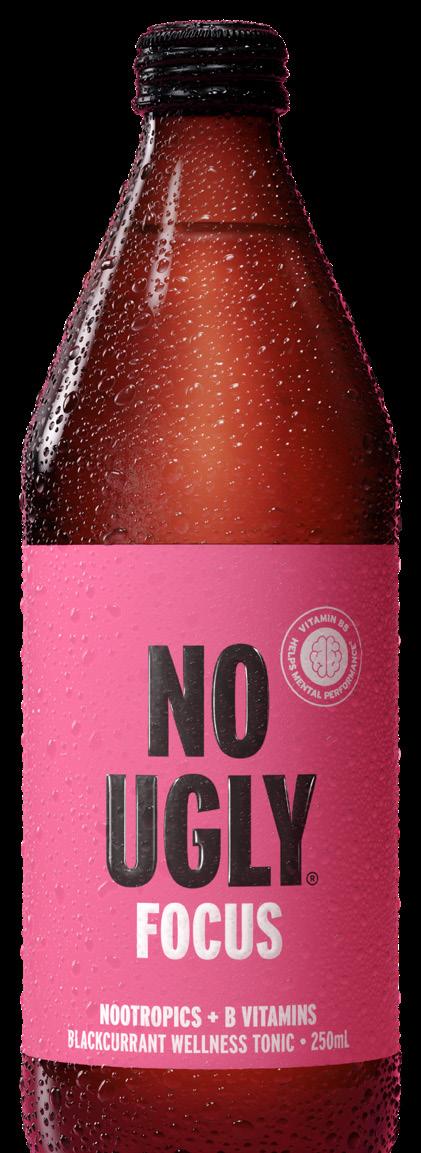
Saturday night. You turn off Sydenham Road in Marrickville, winding your way through eerily-deserted side streets. On Fitzroy Street, syncopated breakbeat rhythms rattle the windows of an innocuous warehouse. The lone woman out the front asks you to scarper, looking over your shoulder.
According to the Marrickville Local Environmental Plan 2011, you are in the heart of what the council terms a light industrial zone.
Semi-trailers line Saywell Street, their cabs empty. Big hunkering skeletons. Come Monday morning, truckies will rock up, Dare iced coffee in hand, cigs behind ears, ready to fill trailers with boxes, pallets and kegs. Just around the corner on Sloane Street, M&J Chickens slaughters roughly 14,000 chickens per day and employs over 100 staff who run deliveries non-stop, Monday to Friday.
Waves of distortion and electric guitar riffs buffet in the wind, competing with the bass vibrations of a free laneway rave. Somewhere nearby a punk band performs in a matchbox sized room.
specific (for obvious reasons), some events inhabit a legal grey space, and it’s no secret that open drug consumption – keys on the dancefloor, nang bars, that kind of thing – is socially accepted and normalised in these spaces.
This need for secrecy means that the stories and history of this area fall between the cracks, evading media scrutiny and state archives. It’s all very hush hush. It’s vital for the prosperity of DIY culture. But there’s an unfortunate disconnect from the past. Knowledge of the area’s history is hardly widespread among the Inner West goth enbies, e-boys, eshays and dreadlocked wooks who frequent Marrickville’s underground creative spaces.
Questions of whose land this is and what ecosystems we have altered in the pursuit of industry are important. As we numb ourselves into drug-fuelled stupor or rejoice that community persists in this culturally-vapid city, we also party on stolen land.
In Marrickville, these questions have a tendency of rearing their head at unexpected moments. But they should be predictable – the frustrating end result of settler colonialism and late stage capitalism. Marrickville’s boho warehouse district, built over a swamp, has witnessed 200 years of perpetual flooding, capitalist greed and class conflict, and we still haven’t learned our lessons.
It’s an ecological shitshow.
* * *
Exploiting land in Marrickville for profit is a colonial tradition. It’s embedded in the very origins of the suburb.

the Cooks River. The size of Gumbramorra Swamp fluctuated significantly, depending upon rainfall and weather patterns.
Of course, it was not a ‘swamp’ to everyone. Nature is socially constructed. It doesn’t exist out there as a purely physical environment. Nature is in here, in our minds and collective memory. The invaders labelled the expanse a swamp, not a wilderness, creek, or estuary. In their eyes, it was ugly and infertile, a barrier to farming and urban development. Aboriginal people, meanwhile, continued to live in the valley and read the landscape.
The waterways provided important resources – black shelled mussels, shellfish and eels. In the early years of the Sydney settlement, Indigenous resistance fighters including Pemulwuy used the rushes and bogs around present-day Marrickville to evade capture.
This was a form of checkerboard segregation. In colonial diaries, pencil sketches and artworks, observers noticed Aboriginal people using the Cooks River waterways and valley until at least the late 1860s. In the 1830s, for example, the Quaker missionaries James Backhouse and George Walker recorded Aboriginal people in bark canoes spearing fish on the Cooks River near what is now Marrickville Golf Course. “We were swamp walkers”, Dharawal elder Aunty Fran Bodkin has told historian Sue Castrique. This area was a refuge for its original inhabitants.
But that refuge didn’t last. Gumbramorra Swamp and the Cooks River, which provides Marrickville’s southern border, were both quickly polluted.
You cut through laneways where graff tags curl around brick walls like shark netting and rubbish spills onto tarmac. It’s a warning, warding off predators who misunderstand the creative micro-utopia hidden within this urban labyrinth.
Hugging the south side of Sydney’s Inner West, Marrickville is well into the process of gentrification. Real-estate agents flog off mould-infested, three-bedroom terraces for $1000 a week to naive students, while spruiking the suburb as the “new Paddington” or “new Newtown” to yoga enthusiasts and marketing executives.
At the same time, a few struggling creatives still pay cheap rent in communal living spaces, making homes, sesh dens and studios in the urban ruins, laneways and warehouses near Sydenham Station.
Across the last thirty years, leaseholders and residents, alongside outside party organisers, have thrown raves, band nights and mid-week exhibitions regularly with little consideration for licensing laws, sound limits and OH&S.
Although COVID-19 has led many worn-out creatives to turn their backs on events, what artistic production still occurs often flies under the radar. There’s a reason for this. Without wishing to be
For much of the nineteenth century, Marrickville was an impassable swamp, skirted by mudflats, mangroves, the creatively-named Swamp Road (now Sydenham Road) and, on its southern side,
The Cooks River region reinforces the recent turn in historiography which emphasises the prolonged presence of Aboriginal people in Sydney. In Hidden in Plain View: The Aboriginal People of Coastal Sydney (2017), Paul Irish counters the myth that, between the 1820s and 1880s, Aboriginal people disappeared, died out, or lived only within fringe camps on Sydney’s outskirts. Rather, they used “mental maps” of familiar and dangerous zones to navigate colonial society, inhabited coastal areas that had not yet become white neighbourhoods, and established crosscultural relationships with sympathetic locals.
By the late 1860s, one of the key resources for Aboriginal groups in the area had disappeared altogether. In a submission to the Royal Commission on Oyster Culture 1876-1877, WJ Langham, the Inspector of Oyster Beds in Sydney, revealed that the Cooks River was “totally devoid of oysters. The mollusc was once plentiful in it, but it has not been worked in nine or ten years”. Meanwhile, the commercial harvesting of oysters in the Georges River continued unabated, suggesting that the ecosystems of the Cooks River were disrupted especially early. Sydney’s burgeoning population feasted on oysters – a mouth-watering treat. In 1838, Albion’s Coffee House publicised “oysters (fresh from Cook’s River) stewed and cold”. But the depletion of oyster beds can be linked more directly to the local building industry, which used oysters to create lime, a predecessor to cement mortar.
In 1881, a tramway was constructed on the western edge of Gumbramorra Swamp – now Victoria Road in Marrickville. Even though it was common knowledge among locals that the area flooded, surveyors, sensing a feeding frenzy, moved in with circumferentors, pencils, maps, and fence palings, attempting to tame the swamp with straight lines and cadastral grids. In the 1880s and 1890s, Marrickville was transformed from a rural nirvana – a leisure retreat with grand estates, market gardens, dairy farms, and timber camps – to a densely-populated working class neighbourhood.
Thomas Saywell drew the first plan for the housing subdivision called Tramvale. He sold the estate to three Sydney businessmen: Mathias Bohrsmann, Henry French, and William Shirlow. The trio created further subdivisions, fashioning 160 allotments in total. One month later, these postage-stamp sized allotments went
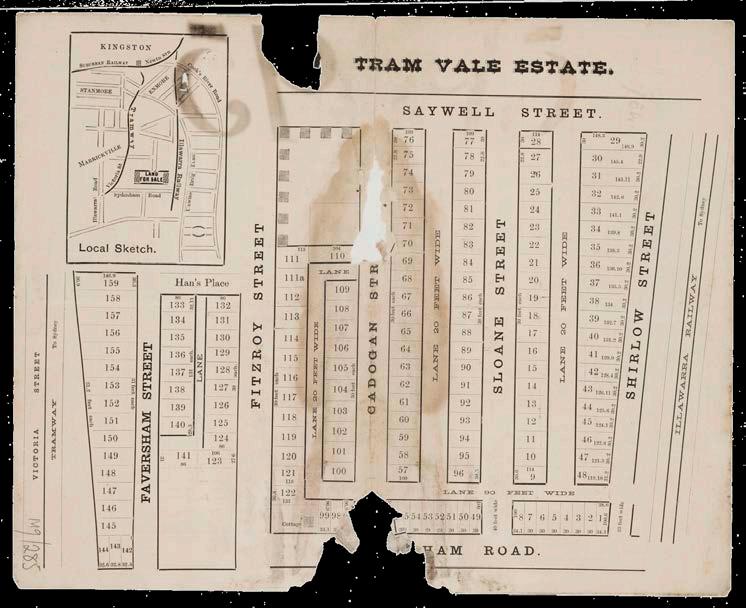
HONI SOIT WEEK TWELVE 202214 | MARRICKVILLE
Swampcore: An environmental history of Marrickville’s boho warehouse district
Robbie Mason sifts through archives, both official and informal.
"Real-estate agents flog off mould-infested, threebedroom terraces for $1000 a week to naive students, while spruiking the suburb as the 'new Paddington' or 'new Newtown'"
“Indigenous resistance fighters including Pemulwuy used the rushes and bogs around present-day Marrickville to evade capture.”
Subdivision plan for Tramvale, 1881. Image courtesy State Library of NSW.
"Marrickville was transformed from a rural nirvana ... to a denselypopulated working class neighbourhood."
to market. The land was cheap. It was also at the heart of the swamp.
1881 was a drought year. Over subsequent years, the waterways continually revolted, taking prisoners. They seemed to burst like ruptured stitches, uncontainable.
Tramvale was notorious for its frequent flooding, stench, and polluted waters. When floodwaters receded, they left behind a reeking dark coat of waste from tanneries and boiling down works upstream. Sewerage flowed into the valley, unregulated. Writing in 1894 for the Evening News, one journalist detailed the customary method of alighting from the train at Illawarra Road to reach the Marrickville Council Chambers: “holding one’s nose” and “bolting” down the street “at a double”. According to the Daily Telegraph, Marrickville was a “marsh in winter, a place of puddles and fog and all manner of chest and lung infections, and in summer a spot where fever lurks and mosquitoes and winged vermin do congregate.”
The worst flooding occurred in late May 1889 when 432 millimetres of rain hit Marrickville in a single weekend. By way of comparison, rainfall at Observatory Hill in Sydney for the entire year in 2021 was 1290.2 millimetres.
“Tramvale was turned into a huge lake”, the Sydney Morning Herald reported. “Nothing but the tops of fences, the tufts of trees and the roofs of huts and houses was visible.” In some parts, the waters were 9 to 10 feet deep.
While the sight and smell of a flooded Tramvale was horrific, for some the sound of repairs became a source of comfort. After the 1889 flood, The Daily Telegraph reported that “the recent phenomenal rainfall has, no doubt, brought gladness to the heart of many a labourer to whom ordinary avenues of employment were closed… The sound of the saw and chisel and the pick and shovel will be heard in the land for months to come, and the song of workmen at their toil will mingle with a deep diapason of malediction from roofless and involuntary employers.”
Some historians like Michael Cathcart, Diane Collins, and Peter Denney assert that colonial-era writers were obsessed with the notion of “bringing civilised sound and redeeming song to a timeless, silent land”. One haunting sound came to define Australian wilderness in the national imagination: a sound of emptiness, stasis and death. It was silence. It was terra nullius.
Left: Standsure Brickworks in Marrickville, 1922.
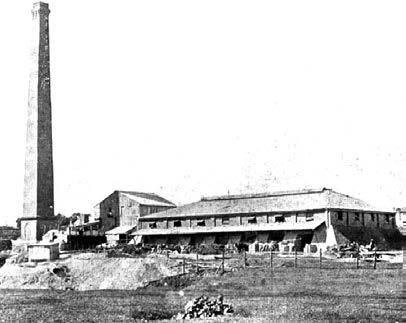
Right: Speare’s Brickworks in St Peters, circa 1891, an ecoapocalyptic landscape.

Images courtesy Marrickville Council Library and History Services.
into something more familiar. They yearned for the thud of axes on wood, the jangle of horse bridles, the lowing of cattle and the crack of stock whips. They coveted any auditory confirmation of progress.
That some people were even able to find a silver lining in Tramvale’s constant flooding tells us a lot. Unable to gloss over the impoverished scene before them, chroniclers shifted their gaze and found a new focus point. They sold themselves a new story. Tramvale was not a failure but a victory – for modernism, working class resilience, and human ingenuity. Behind all these actions lurked a sound – or more precisely a lack of sound – so intimidating that it overpowered everything: the bellow of silence.
* * *
From the late 1890s, authorities began to oversee the construction of the stormwater drains, aqueducts and drainage pits we recognise today. The swamp was drained. Much of Tramvale was designated for industry and manufacturing, although many residents chose to stay in houses that flooded every few years.
the Addison Road Community Centre in Marrickville, she investigates the concrete stormwater catacombs below Marrickville. “Just as the creeks became known as drains, so the waterholes were stripped of any understanding that they were part of a wetland”, she writes. “Names were erased, and soon the ‘old swamplands’ were no longer even known as Gumbramorra”. Today, contemporary flood maps of Marrickville mirror the locations of historical creeks. It’s a question of language once again. “Have we been inundated by a flash flood?” Castrique asks, “Or are we fording an ancient creek that has risen again?”
* * *
It’s easy to corral our ancestors into a corner using our contemporary standards as cow prodders. But the farmer and environmental historian Eric Rolls has fought back against perceptions that the colonisers were simply “greedy or ignorant” when it came to environmental care. In his eyes, it was “beyond human achievement to assess this land correctly” because to them, Australia was “more a new planet than a new continent”.
The invaders filled the pages of their diaries and newspapers with descriptions of eerily quiet forests and silent deserts. Sometimes disconcerting native animal cries shattered the serenity, but generally there was only muted background noise on the frontier. Of course, the land was never really silent. That’s just how the invaders chose to describe it. They sensorially disciplined the land with selective memory. Looking to the future, they hoped to transform Australia’s alien soundscapes
Marrickville and neighbouring Sydenham became part of an industrial belt stretching from Alexandria to Botany. Wool mills, pottery workshops, brick pits and automotive factories dominated the Marrickville skyline. Marrickville became Sydney’s premiere brickmaking site. In 1888, Johnston Brothers was producing up to 300,000 bricks per week. Today, Inner West libraries hold locally-produced bricks – crude, heavy souvenirs (trophies?) of dispossession and environmental degradation – in their archives as realia.
As the brickmaking industry waned, locals let the brick pits, usually located beside or atop natural waterholes, fill with water. They also used these barren moonscapes as garbage dumps. In 1897, The Daily Telegraph reported:
“Garbage was being deposited on a piece of vacant land, with the object of filling up a number of clay pits. No attempt appeared to have been made to cover the refuse, and a very offensive smell arose from the tip…. Water, polluted by its passage through the garbage flowed into an open drain, which in its turn, passed through the most thickly populated parts of the borough.”
In her essay ‘On the margins of the good swamp’ (2019), Sue Castrique reflects on settler amnesia. Prompted by her own shock discovery of a creek below
Tramvale, and the subsequent industrial area it became, sit smack bang in the middle of what is now Marrickville’s boho warehouse district. This region also used to be the heart of Gumbramorra Swamp. Probably. The precise locations of the swamp’s boundaries are still debated. Those benign founding fathers Thomas Saywell and William Shirlow gifted their names to the very streets –Saywell Street and Shirlow Street – where iconic warehouses and BYO venues have appeared. Two Flies, Dirty Shirlows. As much as we want to, we can’t seem to shake off the past.
In early February 2020, water overran the Marrickville warehouse district particularly badly. Water infiltrated bedrooms on the second level at the Sashimi warehouse on Fitzroy Street as a result of a “dodgy roof”, leaving behind sodden, mould-caked surfaces, according to Lachlan Waterhouse, a resident and musician there at the time. At ground level, the building flooded. Mothership Studios, meanwhile, lost audio gear to the water. Lachlan recollects looking out the window from a friend’s room at Mothership: “It looked like Venice. Skip bins were floating down the road and cars were getting flooded. You could have ridden a gondola down the streets”. That torrent of sticky resistance was surely a reminder: this is Gumbramorra Swamp territory. This is marginal land.
This is not your land.
At the end of its life, just before COVID hit and the building was sold, Two Flies flooded. There was a foot of water where the dance floor used to be. It must have been as if the ground itself was moving, fighting back. As the sloppy mess pooled, Two Flies keeled precariously like a ship in stormy seas. Weighed down by the load of over a century of colonial greed and a global pandemic, the vessel that had transported thousands of party people to another dimension eventually capsized. There wasn’t even time to launch the lifeboats.
Undoubtedly profit maximisation drove the sale of land in Tramvale, which should never have become a residential area in the first place. Capitalist greed was a formidable power. But in the late 1800s and early 1900s, locals also wrote to Marrickville Council, attended town hall meetings and created petitions in which they lamented the sight of maggots, dead fish, and grease on the weed-filled banks of the Cooks River, as well as the stench of the streams and creeks which branched off from it. It seems unlikely that individual health concerns and financial anxiety alone stimulated community unease.
While Gumbramorra Swamp was only ever an obstacle and an inconvenience, is it possible that the invaders developed an emotional connection with the Cooks River? Is it possible that the pitiful state of Marrickville’s waterways engendered in some locals a deeper spiritual sadness? Is it possible, perhaps, that some grew to appreciate the river on Marrickville’s doorstep?
If so, they were too few in number and too trapped within the cogs of the capitalist machine to turn things around for the polluted river.
Eric Rolls wanted Australians to appreciate the agency and dynamism of our natural environments. In his groundbreaking writing, Rolls demonstrated that settlers were both capable of immense environmental desecration and subject to the whims of Australia’s alien lands and creatures. Following this thread of thought, we begin to see trees and rivers as agents of historical change. Rolls’ wilderness is not pristine and untouched, but “feral, mongrel and hybrid”, as Tom Griffiths writes in The Art of Time Travel (2016).
Rolls mostly wrote about Australia’s forests and grasslands, but this vision of nature can be equally applied to the swamps, mudflats, and waterways now buried beneath Marrickville. Those murky depths swirl underfoot, defying linearity. They’re an indeterminate zone – not quite land and not quite water – hidden away but never contained. Ready to retaliate.
It’s not the tide of progress that defines Marrickville but the swamp of history. The past expands and contracts, circulating sometimes as a dribble and at other times a torrent. Oftentimes, it feels like the suburb is trapped within a time loop of perpetual flooding and class conflict.
HONI SOIT WEEK TWELVE 2022 MARRICKVILLE | 15
“Have we been inundated by a flash flood?” Castrique asks, “Or are we fording an ancient creek that has risen again?”
"One haunting sound came to define Australian wilderness in the national imagination: a sound of emptiness, stasis and death. It was silence. It was terra nullius."
"They lamented the sight of maggots, dead fish, and grease on the weed-filled banks of the Cooks River,"
A thousand days of duolingo

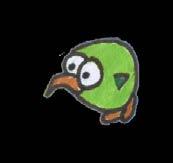

 Nicola Brayan logs on.
Nicola Brayan logs on.
On the eleventh of October 2022, my Duolingo streak hit 1000. For almost two and three-quarters years, I had completed a lesson — in either Italian or Arabic — (pretty much) every day. I have completed daily Duolingo lessons for longer than Bennifer’s first romance and for longer than Julius Caesar was at the head of the Roman Empire; if a child was born the same day as my streak, it would now be learning how to construct phrases. I wish that I could say that this intense commitment was purely born of a passion for learning, but truth be told, there’s something else spurring me on. Seeing my streak grow every day brought me a sense of satisfaction. Getting a notification at 10pm saying my streak was at risk made me panic.
Realistically, missing a day or two of Duolingo would not massively stunt my learning. And yet, I have come to love this streak as if it is a child. If you’re like me, you’re probably wondering: why am I like this?
Let’s start from the beginning. I, just as many others do, picked up Duolingo to maintain a language I no longer had the chance to formally study. I studied Italian from year 7 to year 11 before dropping it because I had too many units for the HSC, and then Arabic in my first semester of university as an elective. Without any contexts in which I could organically practice either of these languages, such as talking to native speakers, I turned to Duolingo to try to retain what I had learnt.
As a part of my research for this article, I spoke with many students, who largely had the same experience as me: using Duolingo as a substitute for time- and resource-intensive language maintenance, such as studying it in a class or immersing oneself in a speech community.
Others used it to study for something outside of classes, like revision for exams, travelling overseas, and even, in one sweet example, learning a significant other’s first language.
To maintain language skills, however, simply starting to learn isn’t enough. You need to practise your skills regularly to keep and improve them. As such, there are multiple features built into the app to encourage users to keep coming back.
There’s a weekly leaderboard, where the points you’ve earned from completing lessons are compared to other language-learners’, complete with different “leagues” that you can climb into or drop out of by gaining points. There are notifications which remind you to practice, which Duolingo cultivate and target to increase the chances of you responding to them. There are challenges, often based on completing a certain number of lessons, through which you can
ART BY SAM RANDLE
win in-app prizes like “gems” or “streak freezes”. And, most saliently to me, there’s your streak: a cumulative total of all the days in a row you’ve completed a lesson.
I have stints where I complete Duolingo lessons — sometimes multiple a day — out of the sheer joy of learning language. It is something that I really, earnestly love. But on days where I am busy, or tired, or occupied by something entirely other than joy for language, there’s one thing that keeps me returning to the app, and that is the streak. As such, I became concerned that perhaps, instead of using Duolingo to learn, I was using it to scratch some other sort of itch; one that gave me a hit of dopamine with every increased integer.
points I’d acquired in my lessons — to prevent me losing my whole streak. One time, after a particularly long night, I opened the app to see the streak counter reset to zero. A teary-eyed Duo (the green owl mascot) informed me that my 800-something streak had been lost. I wish I could say otherwise, but I started to cry. Looking back, this reaction was likely partly the fault of the alcohol I’d been consuming instead of doing my daily lesson, but it really did feel awful.
Not only had I lost something I’d spent over two years cultivating, but I was struck by the realisation that I simply did not want to start another streak. No matter how much joy I associated with language, the knowledge that I was two years away from getting back to the point that I had been at minutes ago was so thoroughly deflating that it sapped me of all will to start again. Luckily for me, the zero had been a glitch. Duo greeted me the following day with a “Phew!” and a reminder to restock my streak freezes. My three-digit streak was back. But that lingering feeling, the knowledge that my obsession with a streak is greater than my love of language, has not left me.
perspective, as it encourages users to engage with the app to the bare minimum extent. Even though I go through phases of doing multiple lessons a day, I’ve found that I really only complete one lesson — the bare minimum to increase my streak — most days, and on especially hectic days, I’ll specifically choose to complete an Arabic lesson, as I’m less far advanced in that course and the content is less complex than my Italian lessons. And yet, despite all of this, my streak has single-handedly kept me learning, almost every day, for almost three years. Surely, that has to be a good thing.
I spoke to Professor Alex Blasczynski, a clinical psychologist who specialises in addictive-type behaviours (he also uses Duolingo, to study Russian). He was very quick to reassure me that no, I was not addicted to my Duolingo streak. “Addiction is pursuing some sort of repetitive or pleasurable goal despite the presence of adverse consequences,” he told me, or in less academic words: “gratifying a need despite the crap that it causes in your life.”
In Blasczynski’s research into video game addiction, he has observed people who pour endless time and money into games, purely to climb leaderboards. Given that I am not sacrificing much beyond a few minutes of my day, I am far from falling into this category.
Instead, he suggested that users are motivated by something else: fear of losing something we’ve acquired. “You’ve worked hard towards getting a thousand streak, and if you then end up losing that particular streak, that’s regretful,” he explained. That is to say: I’m not motivated by seeing my streak go up, but rather by a fear of seeing it drop down to zero. “The regret is emotionally worse than the pleasure of winning the next points.”
Professor Blasczynski pointed to other instances where this fear is weaponised, such as Frequent Flyers points, to keep people engaging in a product. Losing a status that you think you’ve worked hard to attain is upsetting, and people will often act to maintain statuses, even if they make very little tangible difference to their life.
To come clean: there have been days where I have not completed a lesson in Duolingo. Each time, I’ve had a “streak freeze” — which I “purchased” using the

In my conversations with other students, streaks are polarising. Some consider them a good incentive to keep using apps like Duolingo; my friend Kritika described getting a “weird sense of satisfaction” from seeing her Duolingo, Wordle, or Snapchat streaks increase, but admits that she uninstalled Duolingo “out of spite” after breaking her streak. Another friend, Branko, thought streaks are only effective in the short term — “at zero days, a ten day streak seems like an achievement. But say you’re at 80 days, at that point, getting to 90 seems trivial.”
Duolingo is not the only platform that uses streaks. For many of us, Snapchat was our first experience with an app that promoted holding a streak. Streaks are, fairly transparently, a marketing tool to keep you using products, weaponising your fear of losing them against you. With that being said, I don’t think that makes them inherently evil. I have recently downloaded an app called Habit, which tracks my completion of healthy habits. I use it to log how much water I drink, how often I water my plants, and how often I remember to vacuum. Unbeknownst to me when I downloaded the app, it, too, lets you hold streaks for completed habits.
This has been excellent for me. I have consistently been completing helpful habits — making my bed, increasing my step count — because of how salient my commitment to them is to me. Is it a gimmick to keep me on the app? Maybe. Has it tangibly made my life better? Yes, actually. And despite the emotional toll it may take on me, I would say the same is true for my Duolingo streak.
Others, like Nida, said that streaks are most effective when they’re longer, suggesting that the harder streaks seem to restart, the more you feel compelled to continue. Imogen suggested that, even though streaks may be slightly manipulative, having a streak on Duolingo is worthwhile, as it’s proof of the effort you’re putting into learning a language, which seems like a net positive.
Many, however, think that streaks are actively bad. “You can lose focus on the main goal, which is to learn a new language,” Drew said. This partially accounts for why the prospect of losing a streak was so demotivating for me: “my motivation is learning my partner’s language, and I have to remember that, otherwise I’ll fall into a slump again.”
Oskar suggests the mechanism isn’t even effective from a company’s
In the time I have held my streak, my world has completely changed. It began on the 15th of January, 2020. I had not heard of Coronavirus at that point in time. In that time, I haven’t had a chance to so much as think about travelling to Italy or an Arabic country to immerse myself in the languages. I would not have retained as many of my skills as I have without Duolingo.
What’s more, these last few years have been pretty shit. The joy I get from learning, from language, and from keeping my streak has been valuable to me. Maybe I’m the victim of an incessant green owl, or maybe I’m dedicating my time to a pursuit that is meaningful to me. I hope to keep up my streak well into the future, but even if I don’t, I hope to retain the joy I feel while learning enough to keep it up, even if the counter
HONI SOIT WEEK TWELVE 202216 | PERSPECTIVE
“I have completed daily Duolingo lessons for longer than Julius Caesar was at the head of the Roman Empire.”
“A teary-eyed Duo (the green owl mascot) informed me that my 800-something streak had been lost.”
“I’m not motivated by seeing my streak go up, but rather by a fear of seeing it drop down to zero.”
Golden age of double-barrelled surnames begins in federal parliament
Samuel Garrett-Garrett does a long-winded roll-call.
Amid the frenzied noise and historic results of the 2022 Australian federal election, a quiet revolution took place. Never before have so many individuals with double-barrelled surnames been elected to the Australian parliament at the same time. Doublebarrelled surnames have been growing in popularity across the country in recent years. However, until this year’s election, the double-barrelled parliamentarian had remained among the rarest of political animals. To date, just 22 individuals with double or hyphenated surnames have served in the federal parliament, but the 2022 election may well prove a harbinger of change in more ways than one.
The history of double-barrelled Australian parliamentarians dates to the very first federal election in 1901. Former Glasgow-born butcher and Rockhampton mayor Thomas Macdonald-Paterson was elected to the House of Representatives as the inaugural Member for Brisbane and the first double-barrelled parliamentarian of the fledgling federation. Born to Helen Macdonald and Andrew Paterson in 1844, Macdonald-Paterson lost his seat after just one term and died shortly thereafter — too soon to see the election of the next to follow in his footsteps: Sir Walter Massy-Greene in 1910. A protégé of Prime Minister Billy Hughes, MassyGreene may well have become Hughes’ successor and Australia’s first and only double-barrelled prime minister had he not lost his seat in the 1922 election. Undeterred, he moved to the Senate in 1923 where he joined Senator Edmund Drake-Brockman, who had taken his seat three years prior.
Fortunately, the departure of Massy-Greene did not leave the House of Representatives without a doublebarrelled member, since the election of 1922 also saw the ascension of Jack Duncan-Hughes, former private secretary to the Governor-General. Defeated in 1928 but seemingly finding politics irresistible, he would later serve six years in the Senate before returning to the lower house for another term in 1940.
Sir Billy Kent Hughes was the first of the post-war double-barrelled MPs and the first to be part of the modern Liberal party. A hurdler at the 1920 Olympics, Kent Hughes added Kent to his surname to avoid confusion with the far more prominent Prime Minister Billy Hughes. Known as the Victorian “Minister for Starvation” during the Great Depression, a defender of cricket’s Bodyline tactics, and author of a 1933 article entitled ‘Why I have become a Fascist’, Kent Hughes nevertheless became Chairman of the 1956 Melbourne Olympic Organising Committee and served in parliament until his death in 1970, outlasting the one-term William Bridges-Maxwell.
Meanwhile, in 1958, Sir Tom DrakeBrockman would break a 20-year drought of double-barrelled senators, following in his older relative Edmund’s footsteps as the sole double-barrelled senator between 1959 and 1978. His only company throughout the 1970s was a brief appearance from the first doublebarrelled Labor MP, Alfred AshleyBrown in the lower house.
The next two years would be the last time in Australian history that the federal parliament lacked a single double-barrelled politician. By 1981, Liberal senators Noel Crichton-Browne and Florence Bjelke-Petersen had been elected. Bjelke-Petersen, or ‘Lady Flo’ as she was known, was placed at the top of the Queensland ticket at the behest
Does USyd value its PhDs?
Sam Randle writes.
As an aspiring academic I have recently started looking at universities at which to pursue my PhD. While professors have generally advised me that the reputation of your doctoral supervisor

is more important than the institution, I wanted to verify the claim. I aggregated data from academic staff from the School of Chemistry at the University of Sydney with the hypothesis that professors would
of her husband, infamous Queensland premier Joh Bjelke-Petersen, and served for 12 years. Powerbroker CrichtonBrowne would be expelled from the Liberal party in 1995 for harassment of a journalist and later pleaded guilty to fraudulently claiming taxpayer-funded expenses.
Leader of the Australian Democrats Natasha Stott Despoja would be elected in 1995, followed by Concetta Fierravanti-Wells ten years later. However, it would be the 2007 election of Sarah Hanson-Young to the Senate that heralded the coming of a doublebarrelled bonanza, particularly among the Australian Greens.
Despite their small number, double-barrelled parliamentarians have had a tenacious presence in Canberra, with at least one sitting in parliament in all but two of the last 70 years. There have only been 15 years since federation in which there have not been any. Internationally, thanks to the 2022 election boosting doublebarrelled representation in parliament to four per cent, Australia now compares favourably to other Western states such as Canada (3.6%), Ireland (3.6%), New Zealand (3.3%), the United States (2.8%) and the United Kingdom (2.6%).
The 2022 election was a watershed moment for double-barrelled parliamentarians. For the first time in Australian history, there are nine doublebarrelled surnames in parliament, where there had previously never been more than four serving concurrently (beside a brief 12-day period of five in 2017, prior to Skye Kakoschke-Moore’s resignation). The lower house picked up four members, breaking a near halfcentury drought — Elizabeth WatsonBrown, Michelle Ananda-Rajah, Max Chandler-Mather and Louise MillerFrost. Meanwhile, Penny Allman-Payne and Jacinta Nampijinpa Price joined the Greens’ Hanson-Young, Jordon SteeleJohn and Peter Whish-Wilson in the Senate. Six of the nine current doublebarrelled parliamentarians are now members of the Greens.
Historically, particularly in the United Kingdom, double-barrelled surnames have often been a sign of privilege and status, used by nobility to pass down family names connected to estates. This can lead to absurd constructions, such as the famously quintuple-barrelled Richard TempleNugent-Brydges-Chandos-Grenville. For others, however, a double-barrelled name is an opportunity to push back against patriarchal naming conventions, in a more inclusive approach that reflects a sense of belonging to multiple families. In a statement to Honi, Labor MP for Boothby Louise Miller-Frost said she adopted her surname to match that given to her children.
“This reflects my feminist values,” said Miller-Frost. “The children are as much of my family as they are of their father’s family and giving them both surnames reflects that they belong to both families.”
Once posh and now popular, the double-barrelled surname has a long, but untold history in the nation’s legislature. Whether the 2022 election becomes an outlier or a new normal, a golden age of double-barrelled surnames in parliament is at hand.
disproportionately come from Oxford and Cambridge. There is certainly a bias for universities with world class chemistry departments, but it appears USyd values Australian universities; it also
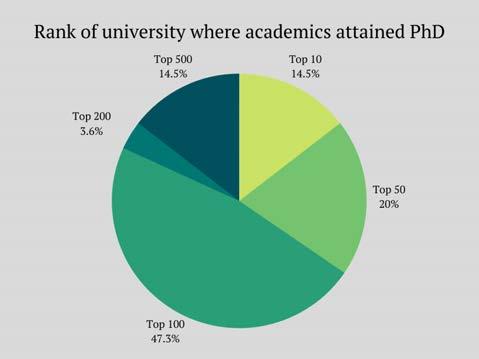
regards USyd PhDs the highest for both permanent academic staff — Professors, Associate Professors, Senior Lecturers and Researchers — versus temporary ones on a postdoctoral contract.
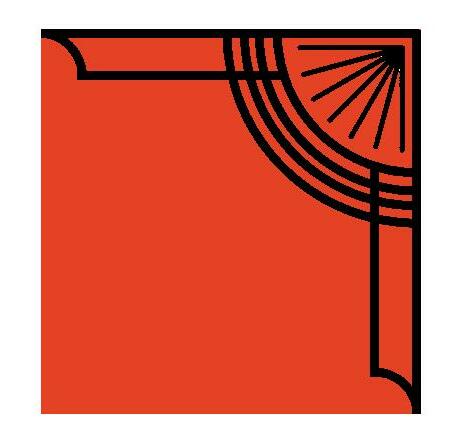


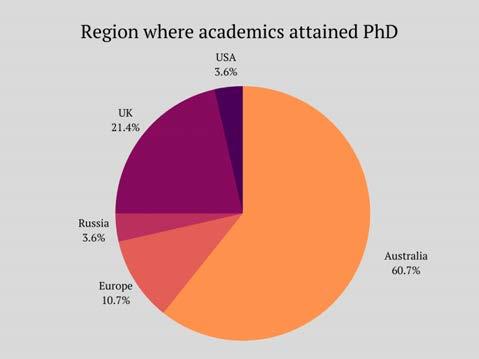
ANALYSIS | 17HONI SOIT WEEK TWELVE 2022
“In 2022 there are nine double-barrelled surnames, where there had previously never been more than four.”
How many worker deaths would you ignore for $277 million?
Tom Wark critiques the behaviour of FIFA, David Beckham and other anti-human rights advocates in the lead-up to the Qatar World Cup.
Every four years since 2006, millions of Australians soldier through inconvenient time zones, broadcaster price gouging, and a growing sense of pessimism about world affairs to watch the Socceroos get humiliated by some of the most athletically gifted individuals on the planet.
But in 2022, the inevitable embarrassment faced by Australia at the hands of France and Denmark on the pitch is nothing compared to the shame and hypocrisy of the global football establishment in legitimising Qatari working conditions that make Willy Wonka’s chocolate factory look like a union paradise.
Everything about the choice of Qatar to host the world’s most watched global sporting event has been mired in corruption and scandal. Many of FIFA’s own rules about hosting tournaments had to be specifically altered, like the time of year the tournament takes place and the geographical spread of host cities, just to accommodate the first Middle Eastern foray into global sportswashing, giving Saudi Arabia a handy blueprint.
Worries for player welfare have seen the tournament moved to November rather than the traditional European summer, to prevent us from having to see Paul Scholes immolate on the sideline. All the stadiums have been purpose built for the tournament and include air conditioning, so that FIFA
haven’t had to develop unmeltable leather footballs.
However, that concern for safety has not been extended to many of those responsible for the stadiums being there at all;, namely, the thousands of migrant workers forced to work in near slave labour conditions with zero protections.
It is estimated that over 6500 workers, largely from India, Sri Lanka, Bangladesh and Pakistan, have died since Qatar was awarded the World Cup in 2010.
This has presented many dilemmas for some of football’s biggest names and many of its rank and file supporters as well.
appears in Qatari ads spruiking how open and accepting this worker’s nirvana actually is. The choice of a man with a full back tattoo of Jesus to advertise your Muslim monarchy should at least make people question the authenticity of his glowing endorsement.
But beyond the Beckham sideshow, the last few weeks has seen some other more respected football figures find out that the serenade of a Qatari accountant can drown out all voices of reason.
Ex-Manchester United player and current commentator Gary Neville announced he penned a deal to work for ITV and Qatar state broadcaster beIN Sports, no less than three weeks after he launched a documentary lambasting the treatment of workers in the refrigerated stadium death camps.
stalwart Craig Foster has said that he will continue to broadcast the World Cup but will not travel to Qatar and plans to use his platform to advocate for human rights protections.
And he is more than just talk. Foster has been a crucial figure in advocating for the ending of refugee detainment and was able to secure the entry to Australia for the Afghanistan women’s football team when the resurgence of the Taliban threatened their ability to continue to play sport.
David Beckham has employed the newly-titled ‘Greg Norman: take the money and a blindfold’ technique, by entering into an ambassadorship contract with the Qatari kingdom, reportedly worth AU$277 million. These deals are generally reserved for those faded stars with room temperature IQs and an impenetrable ignorance of public opinion.
No one truly believes Becks when he
This sudden pivot showed the dexterity normally reserved for Liz Truss crashing the British economy, u-turning and still losing to a lettuce. Suddenly, a World Cup played in temperatures favoured only by Salem witch trials, with no alcohol and the threat of jail for homosexuality, has an enduring appeal for these already super-rich football pundits.
That’s not to say that all broadcasters have been so willing to prop up the global reputation of the latest despotic regime to gain FIFA’s approval.
Australian commentator and SBS
A flag flies at McDonald’s
The clangour of metal on metal, a blur of shirts — red, the prism of voices in pursuit of each other. An order falls on someone no older than sixteen, too young for this; the clangour of metal on metal, the cry of a voice, a helter-skelter undertoned by klaxons and alarms swinging sonic violence — bees in the din. Red shirts swell, desist, buckle, and shake as they face off a motleydressed armada.
And when their day is done, when their leader dismisses them, they step out into the parking lot, pupils dilating to the whisper-light of night, and each and every one of them searches for that red-andgold, the flick-and-swish of allegiance. As on their uniform so it is above, the Golden Arches whip against the night.
Cremorne McDonald’s, amongst others, is one such location that displays the flag of its own logo. Hoisting it at equal height as the Australian flag standing a few metres away, both flagpoles are enjoined by a promotional banner which spans across the distance between them. To this the onlooker responds, interpreting this presentation as a chimeric melding of nationalism and corporatism, a sharp-toothed value-combo of jingoism and capitalist lunacy; One can imagine the boardroom pitch:
Tears brim as you bite into your hashbrown and see the Southern Cross, you think of our boys at Gallipoli — what a waste that was — the hash brown goes down smooth as you switch vision to the McDonald’s flag, peristaltic contractions pullulating the potatosaliva down your system. A shaky smile creases the path of your tears, you nod your head as you think to yourself, as every Australian must, as those ANZACS did; I’m loving it.
Or, alternatively, one might interpret
this semiotic similarity as a shove, a command daring you to treat McDonald’s with that same patriotic reverence expected for the Australian National flag — the presence of which, at McDonald’s, is a concession to goodwill, the handing of an unplugged controller to a younger sibling.
The absurdity of this demand for equalperception by this fast-food giant invokes a disquietude, a challenge to Australia. Through the absurdity of the thought, the claim to the same fame as a nation state, McDonald’s is requiring more attention from the viewer than the Australian Flag. And while It must be admitted that Cremorne McDonald’s seems to follow Australian flag protocol (even flying at half-mast upon the passing of the Queen), a feeling lurks that this is merely legal, mechanical. The essence that slips between this adherence to legalese is the same semantic twisting that allows heads-of-state to declare freedomfighters terrorists, and have them executed without a toe out of line.
And then, disturbingly, what would you make of a customer (and at this point it must be imagined that all Australians have been, are, or will be McDonald’s customers), saluting before the twin flagpoles? To whom are they pledging allegiance?
On a more subterranean level, this form of presentation works as a knife into the brain. A 2016 study focusing on the psychological interpretations of flags and logos indicates that groups with symbols “seem more entitative and threatening as well as more competent but less warm”
Robert Shanafelt, in a 2008 journal article, argues for the flag as a ‘natural symbol’, one that has cognitive connotations linking back to our primate past, noting that
the flag must also be recognised as a physical marker in a 3D space (its ‘topographic context’). Shanafelt argues, with reference to observations by Darwin on the body language of animal hierarchy, that the flag’s high vertical position (relative to that of the viewer) embodies the same meaning as a domineering chimp, bipedal and bristiling in piloerection.
This biological view attends to the same general principles of the psychologist Louis Cheskin, who advised McDonald’s in the 1960s to keep the golden arches as their logo, attesting that the honeyed curves had “Freudian implications”, likening them to a pair of nourishing breasts.
Foster’s strategy represents the ideal scenario for how this World Cup should be covered. It is unfair and frankly unrealistic to expect the players and fans who wait for four years to participate in such an important global event to suddenly boycott at the expense of their personal careers and country’s chances at glory.
But a prevailing silence for four weeks about human rights abuses based on a commodification of labour should not come simply because certain individuals fancy a new refrigerated wine cellar, similar to the one where the bodies of workers were stored in the stadium.
So, when you’re up at 4am watching Benzema and Griezmann slot another four past the hapless Aussies, spare a thought for the thousands of workers who paid the ultimate price to buy David Beckham a slightly bigger tyre for his rope swing.
Aidan Pollock is not lovin’ it.
In considering the financial implications of this action, is it not then justifiable to consider McDonald’s as on a similar level to bonafide nation-states? A rough estimate of McDonald’s workers puts them at 200,000 (discounting franchises), a population larger than countries such as Samoa, Aruba, and Bermuda. The 2021 full-year analysis from McDonald’s published a revenue of $23.2 billion in 2021, making it roughly 108th in the world by GDP (if it were a country), placing it above Iceland.
If each McDonald’s worker were to raise arms, the combined guerilla efforts could cast dozens of countries into the muck with its logistical precision praised by Patagonia’s founder, Yvon Chouinard: “I respect one thing it does. No one at McDonald’s ever tells a customer, ‘Sorry, we’re all out of iceberg lettuce today.’ It successfully organises on-time delivery every day of the week.”
On a more macro scale, the Golden Arches Theory of Conflict Prevention, put forward by Thomas Friedman, expounds that in a world of ever-increasing economic connectivity, any two countries that have the economic health to support McDonald’s will have no ‘interest’ in going to war with each other. Although this theory was suggested tongue-in-cheek in 1998, the growing reality of fiscal repercussions as a form of retaliation described by the theory may hold true, as McDonald’s has announced it will be ‘de-arching’ and permanently leaving Russia following Russia’s invasion of Ukraine (a country with 108 McDonald’s locations).
In the veins of the golden-red flag beat the hidden axioms of imagery that secrete their virus behind our eyes. The culture paroxysms. McDonald’s asks; What honey drips from the sweat of the worker’s brow? What taste is the nectar that colours their chins and drips onto your McRib? Would you fight for McDonalds? Die for it? You might laugh at the thought as you sit in the parking lot, staring at those two flagpoles. To sacrifice yourself? Absurdity.
You take another bite into your cheeseburger, allowing the grease to nestle somewhere under your rib cage. Unaware of the new form of warfare, you chew and chew.
In this new era of international commerce, patronage is patriotism, and every bite sends you to an early grave.
HONI SOIT WEEK TWELVE 202218 | OPINION
“Tears brim as you bite into your hashbrown and see the Southern Cross, you think of our boys at Gallipoli...”
“It is estimated that over 6500 workers...have died since Qatar was awarded the World Cup in 2010.”
I am a dastardly and nefarious character

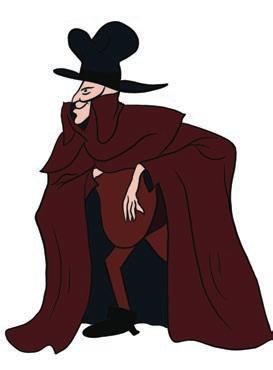
Iam a dastardly and nefarious character, constantly engaging in vile and villainous schemes. While these schemes are various and diverse, they usually have at least some features in common (i.e. how evil and nasty they are). Sometimes I will poison the town’s water supply and twirl my moustache cackling in the Mayor’s face until he proffers me ransom. Other times, I will find the most beautiful woman in the town and tie her to the railroad tracks while, again, cackling and perhaps swooshing my cape in an eerie fashion. Still too, sometimes I will dig a tunnel into the bank’s vault and make away with my ill-gotten gains in the dark of the night. These are the sorts of schemes on which I spend my time.
Although I often make money from my schemes – indeed, if I didn’t enjoy it so damn much I suppose it’d be fair to call villainy my job – I don’t really do it for the money. Mostly, I do it out of the morbid antipathy I feel towards my fellow human beings. I think they are profoundly weak creatures; dopes, even, who are all too willing to have the wool pulled over their eyes and be tricked. Stupid, cowlike things who plod along, contented with their workaday lives. Other people are a bunch of marks – bar the few other villains I know – and I take great pleasure in exploiting them or harming them or somesuch. Take this fellow, for instance, the fellow whose window I find myself peering into now.
I first spotted him on my daily walk
around town. There he was, sitting on a bench in the park, tossing breadcrumbs at the pigeons and tipping his hat at people as they passed. He couldn’t have been any younger than seventy, and he was dressed in slacks and a thick tweed coat. He had a simple, amiable air that seemed to say that whatever the stage of life is where a person has time for hate, he was well past it. He seemed, from my momentary stare, to be decent, ordinary, and kind. I just hated him, and soon decided to make him the subject of my next scheme.
types of villainous and nefarious schemes which I considered pulling on this man; first, however, I had to know more about him. So I followed him around.
To be honest, he didn’t get up to much. He sat and fed the pigeons, then wandered through the park. He sat down in a cafe and drank a coffee while making idle chit-chat with the barista. He perused the books in a local library before picking up a thick military history and beginning to read it in one of the plush armchairs available. So he went about his day, with
telling a story to his granddaughter and doing all the parts of a story that children enjoy — silly voices, funny faces, and so on. He finishes the story with an imitation of a lion’s roar that leaves her giggling in delighted terror, and he picks her up and spins her around above his head, and his wife scolds him but it’s clear she finds it endearing. Then dinner finishes and they clear the table, and his son and his family get ready to leave. He gives his son a long, warm hug, then picks up his granddaughter and kisses her squarely on the forehead, and she beams at him as only a six year old can.
I decided to tailor this particular scheme to him so as to make the sweet sting of my cruelty all the more unbearable. Perhaps, I thought, I might place him in a compromising scenario at the local bordello and blackmail him. Perhaps I’d have his oh-so-beloved park paved over and replaced with a big box store. Perhaps I’d buy up all the tweed jackets in town before stealing his, so he couldn’t find a replacement. These are the
me following not far behind, scurrying from hiding place to hiding place to ensure that he couldn’t see me

Now, I have followed him home. You always have to get a sense of the home life of someone you intend to humiliate in one of your schemes, I say. I am peering now through his window into his dining room. He is sitting at the table with his family — I presume his wife, son, and grandchildren — and enjoying dinner with them. He’s
Then, once they’ve left he gives his wife a kiss and wanders over to the living room. He sits down in a plush armchair -–god, but he does love those, the bastard! He sits in the chair and turns on the television, switching it over to the cricket, though his attention seems to be more focused on the crossword puzzle before him. After not too long he seems to nod off, head drooping down to his chest. His wife comes in and shakes her head and smiles, then pulls a blanket over him before turning off the television and heading upstairs to bed. He lies there for a while, snoring gently, before waking and looking around. He sees the blanket on his chest and gives a grateful smile. He stands, and folds the blanket carefully, placing it on the chair. He switches off the lamp, and heads upstairs to bed. And I find that I have tears in my eyes, that I am crying. Why, why on earth am I crying?
CREATIVE | 19HONI SOIT WEEK TWELVE 2022
Felix Faber gets evil.
“Sometimes I will dig a tunnel into the bank’s vault and make away with my ill-gotten gains in the dark of the night. These are the sorts of schemes on which I spend my time.”
ART BY SHANIA O’BRIEN (ABOVE) & AMELIA KOEN (BELOW)
Your favourite kids’ movie sucks ass – yes, yours specifically. Your tough-day-at-the-office, Mee-Maw’s chicken-soup, soporific, weighted blanket movie sucks ass. I hate it, and you need to stop recommending it. Let me break down exactly why.
First, the content. It is not a good movie. This is to be expected, because it is written for children – like, eightyear-olds – they can’t wrap their tiny heads around a complex plot or a character with an inner life, so what’s the point in trying? This four-car pileup of a film, however, is even worse than typical kids’ cinema.

It is so clearly the product of a dozen focus groups of dopaminedesensitised American children pressing the Big Red Button on the table whenever Main Character makes them laugh (any fart joke) and the Big Blue Button whenever they feel sad (which is never – they, like you, are psychopaths – but they probably came closest when Main Character’s Dog died). None of this should be surprising to you, given you’ve watched it hundreds of times, but I digress.
More importantly, though, is the way you enjoy it. The very fact that you love that shit so much is what I hate about it. You love it because it was the only DVD you had on holiday that one time, but you’ve got to insist that it’s because of your esoteric, elevated taste.
You insist that, “well, actually, it has a surprisingly good message for its time and surprisingly good politics and-”, no it doesn’t! It was made in the ‘90s! Its message is ‘be yourself’, and its “good politics” is that the gay jokes are slightly less explicit. I heard that you say you were going to make a video essay about it, by the way – a forty-minute YouTube video about a kids’ movie.
How pathetic can you be?
The worst part is that I know you’re gonna come out with some stupid “let people enjoy things” [note that this should be read in a mocking, nasal, voice].
Well guess what – I’m not your boss! You can enjoy it all you want!
I’m just delivering my honest opinion that your as-yet unnamed favourite kids’ movie – made, again, for eight year olds – sucks shit, and I hope every copy somehow catches fire and Netflix stops streaming it.
None of this applies to my favourite kids’ movie, The Pink Panther (2006), by the way. That shit whips ass.
There are few foods in this world more vile than fruit.

Most people think fruit is some vitalising miracle of nature, sweet and juicy and nourishing. My parents have fed me this propaganda since I can remember – waving smelly mandarin segments in my face, plopping berries onto the plate of pavlova I had painstakingly removed them from. ‘Just try one bite,’ I recall my mother saying, as she painstakingly sliced a finger-nail sized piece of cherry. ‘You don’t eat fruit?’ new friends will exclaim as I inevitably disclose this fact to them – my party trick – and receive a stare so dramatic that I feel I’ve announced that I am pregnant, or just killed someone.
I say, they are all deluded.
First, because fruit is texturally and gustatorially revolting. Take a banana. I have never tasted one, but can only imagine the sickly sweet, compost-like flavour they might have based on the stench they emit. Then combine that with the mushy yet fibrous texture of their insides – it’s an effort not to gag. Or a passionfruit, with its insides like grainy snot. A mango, its slick flesh like licking the underside of a garden snail. A mandarin, its cloying citrus sinking into every surface that touches it; desks, backpacks, grubby little fruit fingers. What's even more infuriating about so many fruit-eaters is the casualness with which they’ll leave fruit scraps in sterile, non-gastronomical places like classrooms and offices – as though everyone enjoys sitting in a rotting, nauseating cloud of aroma while going about their business.
Second, people who believe in the cause of fruit-eating are so self-righteous about it. They proselytise fruit as though it is a sacred, magical gift. They will sing, ‘an apple a day keeps the doctor away’. They will exclaim, ‘ugh I’m craving some fruit right now!’ – as though anyone craves doing sit-ups, or taking medicine. These smug fruit-eaters are one of fruit’s greatest problems.
And finally, eating fruit is ultimately unnecessary to a healthy diet if you eat a lot of vegetables. Science has proven this. Also, vegetables are just so much better. I love vegetables. I feel emotional about eggplant, spinach, zucchini, asparagus, capsicum, carrots, mushrooms. You can oil them, salt them, herb them, fry them, stew them, salad them, pickle them, smoke them, tapenade them. They are the epitome of yumminess, and all that is morally good. And no, I don’t care that some of them have seeds, so you might call them ‘fruits’. Shut up.
I believe there are more fruit-haters out there, we are all just being quiet about it, scared of the fruitists who dominate social circles. I say, I hope those people choke on their pips.
At the heart of the New Law Building, saddled between split staircases that reach down to the lower chambers of the law school, sits a surrealist portrait portraying two alien-like creatures, crouching in a naked embrace. A judge’s wig, with sides enveloping the frame, crowns these cowering figures – invoking a divine sense of calling, of greater good, and of guardianship.

Its meaning, if one can be found, is surely to inspire. With many hurried trips past this ominous wall, however, an impression forms that behind it lays a crypt, a grave to life sucked from law students, this plaque the only memory.
At law school, the only textbook you are provided, at the cost of $50,000, is your peers. As such, your primary education will come from what you learn at law school, not in law school. You’ll be taken aback by how pleasant everyone is, contrary to stereotypes that USyd’s law students are all cut-throat, sociopathic and self-interested. There is a camaraderie that is rarely given credit here. From them, you’ll learn drive and discipline. Considering barriers to entry, you’ll be surrounded by believers of rules; understanding them, following them, and even making them. This is home to the rule of law, and the law of rules.
Yet as time passes, you’ll learn more uncomfortable truths. Despite what law students might have thought about themselves before coming here, there are three unavoidable realities that tie you together: you can’t read, you can’t write, and you’re all too insecure and convictionless to be doing something else
Five years without parole at any institution is bound to chip away at the soul. Like a cult, you’ll find your identity now tethered to this place, where the thought of leaving is too unbearable, too great an existential risk to what you’ve come to know yourself as – a law student. Youthful restlessness dulls. Values tire and dreams languish. Once a place of opportunity, crossroads become dead ends. In the absence of that something else, you soak up the ambitions of those around you.
A sense of adventure withers into a quest for comfort. You’ll find yourself talking about clerkships and polishing yourselves for interviews, networking events, and corporate panels. You become too busy to even consider if this is ever what you wanted. Only once the adrenaline haze of needing to prove yourself fades, and often when it is too late to turn back, does it dawn on us.
Huddled bare, entrapped by the narrowed view of what is possible within the law, and now too ashamed to make eye contact, we hold each other with the truth. Law school is where dreams come to die, and where we come to kill them.
Being over 6’ is a blessing and a curse. It’s a curse because we are burdened with the knowledge that most people have a demonstrably worse life; a blessing for more than 182.88+ reasons.
Leading universities such as Harvard, MIT, Oxford, NASA, and UTS have conducted comprehensive studies on the benefits of being over 6’. They include being at least 300 times sexier and cuter than your average person and 1000000000 times smarter than people who are 5’ 11.5”.
If you intend on a career in politics then height will also give you an advantage over your opponents. This is because when you’re taller you are both closer to God (therefore divine champions), and have a bird’s-eye view of the social landscape. People who can barely see above their own shoulders are not in a position to lead; the general population knows this. That’s why 68 per cent of US Presidents since 1900 have been the taller of two candidates: In Tall We Trust.

Tallness is also correlated with democratic strength, and conversely, shortness is correlated with fascism. Famous authoritarians have all been short: Napoleon (5’ 6”), Adolf Hitler (5’ 8”), Pol Pot (5’ 9”), and Hen Bines* (5’ 8”) have all ruled with an iron fist.
People who are tall are also better adapted to the climate crisis. We will never get our shirts wet when the floods roll in, can fight bushfires without getting burns (because we are heat resistant), and exhale oxygen while breathing in carbon dioxide.
Haters (a.k.a jealous cunts) will point to very specific instances of height letting you down: having not enough leg space on planes, a sore back while washing the dishes, and people asking you to reach stuff.
Such claims are an unfortunate demonstration of the ignorance of shorties. If you check in to a flight over 6’ they instantly upgrade you to business class; over 6’ 2” you get first class. We also never have to wash dishes because the inferior shorts know their place, offering to do them for us. Speaking personally, nobody has ever asked me to reach something for them either. Being tall makes us empathetic and virtuous (again, because we are closer to Heaven) so we offer to help people in need before they realise they need it.
Finally, shorties know they have it rough. According to a study in the American Journal of Psychiatry, a 5 cm increase in height is associated with a 9 per cent decrease in suicide risk. Being tall is a reason to live in and of itself.
*following the Annexation of New Law.
HONI SOIT WEEK TWELVE 202220 REVIEWS
Yourfavouritekids'movie
Fruit
USydLawSchool
Beingover6ft
0/10: Pathetic + embarrassing Felix Faber Arts III -100/10: Texturally + gustatorially revolting Zara Zadro MECO IV 0.995/10: Graveyard of dreams Christian Holman Econ/Law IV 6'/6: Virtuous + democratic Sam Randle Science (Metrology) V - 6'2"
Before I commence this review in earnest I must make a few disclosures. Firstly, I do not have any South African ancestry. Secondly, I have never been to South Africa and do not have imminent plans to visit. Thirdly and most significantly, I have been publicly imitating the South African accent for the best part of a year.
Since I was very young I have been fascinated by accents. It is comforting to realise that the people and places of our upbringing are always with us, having left their indelible mark on our speech. Owing to a myriad of subtle historical differences, I truly believe that the unique sounds of an accent reveal a lot about people. I live in a British settler colony and I do not pronounce the letter R in words like car and market. Upper-class English society dropped that specific feature (known as “rhoticity”) in the mid18th century - too late to influence the newly independent Americans but just in time for the colony in Australia.
For most of my youth, I had infrequent but distinctly unpleasant exposures to the unique sounds of South African English. If I encountered a teacher or parent or godforbid a peer with the accent I would grimace in discomfort. In my defense, South African accents seemed to consistently accompany the coldest and most judgemental interlocutors of my adolescence.
This year, my ears were struck again by the vowel-shifting sounds of South Africa. As I watched the Australian Open, I was thoroughly entertained by the thenunfamiliar voice of Robbie Koenig who sprinkled idiosyncratic South Africanisms into his commentary. “Berrettini strahkes beck wuth A BULLIT”.
“NADUHL US WORKUNG HUS FENS
UNTO A RELUGOUS FERVOUR”. These sentences and others are etched into my hippocampus like fewer others.
Inspired by Koenig’s commentary, my friend and I began to hone our South African accent imitation skills into a fledgling comedy routine. Today our accents, exaggerated and imperfect as they may be, sound somewhat authentic. They are highly practiced and regularly deployed, which has inspired others to join our project of cultural appreciation.
Though my interaction with real South Africans has not increased much at university, I have allowed the unconscious psychology within their accent to permeate my mind. I realise now that the South African accent is not cold or unfeeling but instead meditative and pensive. Just like the vowels in South African English, my perspective has shifted irrevocably. I commend the South African accent to all. Change your i’s to u’s and shift your yes into a “mmm, Yehz”, you will be so much the richer for it.
Ilove being a lesbian because I get to have sex with women (awesome). This might seem too subjective. But here are the facts: lesbians have the best sex. Straight women reach orgasm during sex around 65 per cent of the time – for lesbians, it’s 86 per cent. This is because there is no way for a heterosexual couple to reach a pure form of love and trust when their relationship is socialised by toxic masculinity. You can’t have so many orgasms without shared lived experience. If you ever thought your girlFriends understood you better than your boyfriend, they do. Sincerely, I’m sorry you don’t get to fuck them.
Outside of the #private, being a lesbian rocks slightly less. When gay liberation took off, many men left their marriages, congregated in the city and created safe spaces, because they held the social and financial capital. Lesbians didn’t have the same economic independence, left at home with kids and deadshit husbands. The chronic lack of lesbian spaces is an ongoing result of this. Sydney had one dyke club. It’s been taken over by men who either come to “watch”, are there with their girlfriends, or think being woke makes it allowed.
Ultimately, the thing that rocks least about being a dyke is that we get the best of no worlds when it comes to gender dynamics: rejected by straight women who we make uncomfortable, sexualised by some men, and seen as a threat to the masculinity of others.
7/10 Wouldn't change it if I could Roisin Murphy Arts (Gender Studies) IV The negatives of being a gay man (homophobia etc.) are muchdiscussed. I won’t entertain a sob story here.Growing up gay, feeling estranged, lost and alone — not ideal. Queer clubbing, queer friends, queer art — pretty great. It’s nice having a shared sense of history and experiences that connect me with queer people I meet. It’s nice knowing that wherever I go, there will be poofters. Like, hi, me too! Let’s be friends! Being friends with lesbians and trans people is also amazing. It’s also nice feeling unshackled from the expectations of masculinity because I have already failed them. Doing something fruity and fun is not a threat to my social standing, it’s expected.
Getting my monkeypox vaccination was a reasonably sobering reminder of the dangers that queer men face. However, the pretty robust public health response was also a reminder of how far we've come, and the institutions that we’ve built to ensure our safety.
I live in the inner west, attend Sydney Uni and work in the arts. I obviously experience very little homophobia. What I have experienced is love, care, and community.

If someone pitched Honi Soit on Shark Tank they would get laughed out of the room. It is a weekly student newspaper run by (alleged) stimulant-addicts, and contributors are paid in social media likes. If you’re considering writing for Honi in spite of this, be aware of the cabal of bored students hoping to flex their intellectual superiority in the comments.
In one of my first forays into writing I got ratioed by a kangaroo fanatic. I would have replied, but at the time my ego was too great and my rebuttals too meagre. I alluded to this experience recently when a job interviewer asked about a time I overcame a challenge. I am still seeking employment.

Honi recently published a perspective piece about student attitudes towards mandatory military service. It suffered a similar fate, as a man – who made it through 141 words before missing the point – questioned the validity of calling South Korea “democratically advanced”. 17 further comments followed, with hot takes about democracy and screenshots from different websites. Interesting points are raised later in the piece by interviewed students – exploring proximity to conflict, social stigma and reactionary misogyny. Unfortunately, no one really cares about these students’ experiences when the thrill of belittling someone on the internet is at stake.
Ultimately, the role of the Honi contributor is to generate dopamine. For the author, there are few greater thrills than scrolling through the likes on your article and seeing people you have never met indicate an appreciation for what you have written. Occasionally you will get a private message, which is significantly more thoughtful and far less superficially valuable than if they had just commented something similar on the post.
You may well have spent thirty unpaid hours with your editor to refine a piece of work that you are proud of, but a pseudointellectual will notice an assumption you made in a filler sentence or attach themselves to a poorly articulated halfpoint that was ruined during the edit. To them you must say thank you, as their comments boost your engagement. It’s a win-win for you, and a lose-lose for them, because either no one knows just how brilliant their opinion is, or they can see it and don’t care.

If you’ve considered writing for Honi but have been scared off by the potential for public embarrassment, just give it a go. In my experience, everyone is really supportive, and if you happen to be good enough at this writing thing to forge a career out of it, you’ve got decades of unhinged abuse from the general public ahead of you. This might be as good as it will ever get.
Today I go where no 'journalist' has gone before.
It is 0047 hours and I am about to do a live review of Novartis Ritalin 10mg, active drug Methylphenidate Hydrochloride. It comes in a silver blister packet of 20.
0048//The tablet is on my tongue. It’s actually not as gross as I thought it’d be.
0049//Ok, no, fuck, now that the middle is melted it’s pretty disgusting. Tastes like I’ve swallowed a soluble version of those metal scalpels that dentists shove in your mouth. The metallic acid-like drool is inching down the back of my throat. Pretty horrible, would not recommend, but still not quite as bad as caps, benzos or mods (which you definitely should not try). I take a sip of tea to wash down that ungodly goop.
While I wait for it to kick in, here’s some relevant background info on the test subject, me. My tolerance is pretty low courtesy of not having an ADHDrelated prescription, but a little bit higher than average due to the generosity of my ADHD-afflicted friends. Ritalin has helped me out through some really tough patches, like when my group for FASS3999 checked out and I had to carry us to a half-decent mark. I’ve also dabbled in Ritalin recreationally, and honestly, it’s as good as Australian cocaine.

0116//Already feeling more awake and alert and good about life. Feels like my eyes have opened a little bit wider. There’s a subtle tingling warmth rising up from the soles of my feet, like I’ve fallen asleep in winter with my toes resting in front of a gentle gas heater, except replace the sleepiness with increasing freneticism.
1:39//The effects are peaking. I'm talking a lot faster and have to slow myself down to not talk ‘at’ people. My stomach is a tad unsettled and my heart is going baboom baboom, but in a good way, like I’m imagining lining up for a 100m race I know I'm gonna win, my body tense and bristling with anticipation. Medicine should NOT be this fucking fun.
3:05//Not gonna lie, I completely forgot I was meant to be doing this review. I got distracted by a designing issue and attacked it with unusual ferocity and focus. I bustled around the room flitting from task to task with extreme efficiency and conviction. Fuck me maybe I’m hypersensitive to this shit but I feel a million bucks. Hoorah!
0410//Beginning to realise I was chatting too much shit at peak chemical concentration about 90 minutes ago.
0637//Yeah look, probably not gonna be awake for my 11am tutorial. Oh well, a small price to pay for original journalism. I can just take some ritalin to catch up.
HONI SOIT WEEK TWELVE 2022 REVIEWS 21
TheSouthAfricanaccent
Beinggay WritingforHoni
Ritalin10mg
11/10: Meditative and pensive Oscar Chaffey Medicine II 9/10: Mostly great Thomas Sargeant Arts (Art History) IV 7/10: Dopamine miners James Frederiksen Arts/MECO IV 6/10: They give this shit to kids Anonyous Arts/Law III
The risks posed by artificial intelligence demand serious consideration
Ensuring that AI systems act in robust alignment with human values is the foremost challenge of our time.
Evan Hockings explains why artificial intelligence is a very real, existential threat to humanity.
Amidst the Russian invasion of Ukraine, the risk of nuclear war is now larger than it has been since the end of the Cold War. The spectre of nuclear annihilation, once thought a thing of the past, has returned.
While technology can avert some forms of annihilation, for example by diverting major asteroid strikes, these naturally occurring risks are likely small, evidenced by our long history free from them. The same cannot be said for those caused or exacerbated by technology. Nuclear war, climate change, engineered bioweapons, and even pandemics: these risks are unfortunately all too familiar.
In his book What’s the Worst That Could Happen? Existential Risk and Extreme Politics (2021), Labor MP for Fenner Andrew Leigh, discusses these risks to our continued existence and how we might mitigate them. But he also worries about another risk not yet listed, a risk that is less familiar and perhaps even more dangerous.
Progress in artificial intelligence (AI) research is accelerating, with the number of new papers doubling every two years. In April, OpenAI released DALL-E 2, a model that generates detailed images from text prompts. While it struggled to generate intelligible text, Google’s Parti, announced only two months later, did not struggle at all. And in August, StabilityAI freely released Stable Diffusion, allowing anyone to download the model, disable the content filter, and generate images on their own computer. While it might be easy to get swept up in the debates raging around AI generated art, we must remember that what we have now is the barest hint of what is coming.
Language generation is where the true prize lies. Large language models (LLMs) are trained on a significant fraction of all human-produced text to predict the text that is most likely to
follow the input text. OpenAI’s GPT-3, released in June 2020, was the first LLM to receive significant public attention, even writing an article for The Guardian. The numerous applications of GPT-3 include writing university essays and powering GitHub Copilot, a programming assistant which suggests code: AI that hastens AI development.
The reasoning capabilities of these LLMs generally improve when they are made larger and trained on more text. Some flaws persist as these models are superhuman at predicting the text most likely to follow the input, which is not always the same as reasoning well.
However, their reasoning drastically improves if we append ‘Let’s think step by step’ to the input text because that makes correct reasoning more likely to follow. What other capabilities are we yet to discover?
difficult for LLMs. Just two months later Minerva, a version of PaLM specialising in mathematical and scientific reasoning, scored 50.3 per cent on MATH, achieving four years of progress in just one.
But there are problems we fear that will emerge in AI, universal problems of intelligent agents that already manifest in humans, corporations, and states. Different people — agents — have different goals, and insofar as their goals are misaligned, some degree of conflict is inevitable. The problems associated with quantifying values and goals are encapsulated by Goodhart’s law: when a metric becomes a target, it ceases to be a good metric. Surrogation, the process by which these surrogate metrics become targets themselves, is rife in corporations and states, leading them to sacrifice the unmeasured good in pursuit of metrics. Maximising profit or minimising unemployment payments, for example, without regard for the resulting harm.
inscrutable AI systems. Eventually, outof-control AI systems might determine that the most effective way to pursue their unintendedly inhuman values and goals would be to seize control for themselves, executing an AI takeover and permanently disempowering humanity.
In 2021, Jacob Steinhardt, an assistant professor at UC Berkeley, created a forecasting contest to predict AI progress, including a benchmark of high school competition-level mathematics problems called MATH. The aggressive progress forecasted shocked him: stateof-the-art AI in 2021 correctly answered 6.9 per cent of the questions, but the median estimated score in 2025 was 52 per cent. In April, Google announced PaLM, which outperforms the average human on a benchmark designed to be
If these problems emerge in AI, the consequences will be disastrous. AIs have many advantages over human minds. AIs do not necessarily need rest or consciousness, can easily be copied, run on computer processors that are constantly improving and operate at a frequency ten million times faster than the human brain, and can use the entire internet and all recorded human text as training data. So as AI systems develop, their role in scientific, technological, and economic progress will grow as human input and control shrinks in equal measure.
In the future, we will likely construct AI systems that, in any specific but general domain, can reason at least as well as the best humans. Nothing in known science rules this out. And under competitive pressures to maximise profit and secure geopolitical dominance, states and corporations may relinquish more and more control over proliferating but

To prevent an AI takeover, there are two key problems we must solve. Alignment is the problem of imparting intended values and goals to AI systems, rather than mere surrogates. Interpretability is the problem of understanding how and why AI systems make the decisions that they do. If we solve these problems, we must then robustly align powerful AI systems with values that promote the flourishing of all humans, and indeed all sentient life, using oversight from equally powerful interpretability tools. While we often fail to do this for corporations and states, humans with power within these organisations can attempt to direct them to act in alignment with human values, and human whistleblowers and journalists can render them somewhat interpretable, limiting the resulting harm. But these mechanisms will not be there to save us from AI takeover if alignment and interpretability work fails.
Unfortunately, progress in alignment and interpretability currently lags far behind progress in AI capabilities. And while some organisations at the forefront of capabilities, like OpenAI and DeepMind, have safety teams focused on these problems, enough is not being done. We charge forward recklessly, headed towards disaster.
Many different skill sets will be required to navigate this risk and ensure that AI brings prosperity to all, from philosophy to computer science to politics and governance. To learn more, perhaps to contribute yourself, see the introduction AGI Safety From First Principles and the freely available course materials AGI Safety Fundamentals, both by OpenAI’s Richard Ngo. And for a lighter overview, see the Most Important Century series by Holden Karnofsky, coCEO of Open Philanthropy.
Climate change was once an obscure and neglected issue, as AI takeover risk is today. I hope that you and the world take this risk seriously, as we have begun to do with climate change, because I believe navigating AI takeover risk to be the foremost challenge of our time, and of all time.
Let’s get to work.
HONI SOIT WEEK TWELVE 202222 | TECHNOLOGY
“While it might be easy to get swept up in the debates raging around AI generated art, we must remember that what we have now is the barest hint of what is coming.”
“Eventually, out-ofcontrol AI systems might determine that the most effective way to pursue their unintendedly inhuman values and goals would be to seize control for themselves.”
ART BY BIPASHA CHAKRABORTY
How I rediscovered a rare cockroach
If we generously expand the definition of “fame” – and of “15 minutes” – I had mine recently, having helped rediscover a purportedly extinct population of cockroaches on Lord Howe Island. The wingless soil-burrowing cockroach Panesthia lata is unique to Lord Howe Island, and was last seen more than 80 years ago. I was pretty chuffed by the interest in the story, not only from scientists, but also the general public, including locals of the island itself.

“I think I killed one the other day,” one told me at the pub, holding up a picture of the flattened corpse of what mercifully turned out to be an invasive American cockroach.
“Is that the same as the stick insect?” asked another.
While not headline news to all, this is a sensational development for the Island’s ecosystem, which has taken two centuries of beatings at the hands of industry, people, and introduced species. Lord Howe Island was completely unknown to humans until 1788, when it was discovered by British colonial sailors en route to Norfolk Island. Encountering an unprecedented and naive island fauna, they immediately set about slaughtering everything in sight. Rejoicing at the “very stupid birds”, one diarist recounts his strategy of breaking the legs of a native woodhen and using its “doleful cries” to attract an additional 60 birds to dispense with.
the supply ship SS Makambo ran afoul of rocks off Ned’s Beach in the island’s northeast. Within 10 years, five species of birds had gone extinct. Within twenty, all reports of Panesthia lata had ceased. Presently, at least 10 invertebrates are recognised as completely extinct from rat predation, with many more likely having disappeared without ever being known to science.
The rediscovery of the roach is poignant in its timing. In 2019, all rats were exterminated on Lord Howe, in the largest rodent eradication ever undertaken on an inhabited island. Seemingly overnight, the ecosystem began to recover. Seabirds absent for over 80 years were seen nesting in the northern forests, those same “stupid birds” hunted by early sailors reached their highest numbers in decades, and, of course, a tiny relict population of soilburrowing cockroaches once more began to grow.
It begs the question: why wasn’t this done sooner? A scientific consortium had outlined the need for rat eradication in the 1970s, and the requisite technological and organisational infrastructure have existed at least since the 1990s. The reasons were, as they too often are, political. Return on investment was a major concern and led to a commissioned cost-benefit analysis. It found that protecting the ecosystem would pay for itself countless times over, as such analyses tend to do.
This highlights a deeply bad faith streak that pervades modern conservation. Many of the ‘concerns’ raised were obviously spurious, intended only to delay ecological efforts, but were cynically branded with scientific terminology. It’s a pattern seen even at the largest scales. Recall the Turnbull government’s $444 million investment into reef “research” and “alternatives”, emphasising strategies to cope with, rather than counteract, climate change. The jury is well and truly out on that front: unless the seas cool down, no amount of alternatives will save the Great Barrier Reef. I’m sure it’s a coincidence that the board managing that fund is supported by BHP and Rio Tinto.
ART BY MAXIM ADAMS
threatening them in the first place. It extends a precedent established in 2019, when the Environment Department circulated internal memoranda explicitly blocking scientists from assessing and listing new ecologically threatening processes. Again, the fact that these threats arise from industry, agriculture and development is surely no coincidence.
However, for all their efforts, sailors could never match the destructive powers of rodents. Rats reached the island in 1918, swimming ashore after
Other objections from stakeholders included the assertion that rats had reached “equilibrium” within the system and need not be disturbed, that it could affect agricultural output, or that the side effects of the rat poison were unknown. Each argument was systematically rebutted, and in 2015 the eradication was finally launched following a plebiscite of the islands’ citizens, where it scraped in with 52 per cent of votes.
Very recently, the Federal government announced a bold new commitment to “zero extinction” going forward. This initiative dramatically expands the number of species and communities listed as threatened and endangered and is touted by interested parties as a sorely-needed return to science. Yet, as critics point out, it curiously neglects to acknowledge the processes actually
At best, these strategies show governments baulking in the face of the modern environmental catastrophe and scrambling for an easy fix. At worst, “research” is deployed by managers as a smokescreen to advance financial selfinterest under the guise of scientific rigour.
The case of Lord Howe Island exposes the frailty and cynicism of managers’ calls for due diligence and alternatives. Upliftingly, it also shows that we can still push through to face ecological problems head-on. I can only hope that the cockroach inspires more conservation research to translate into conservation action.
After RepsElect, I was wandering home through the Inner West around 1am. It was a clear night and the street was well lit. I looked up to see a small ringtail possum sitting on a powerline above me. The possum was little — bunny-sized, and cute, of course. I made a soft gasp, delighted at its presence here in suburbia. The possum looked down on me, relaxed. I felt the sighting must be a good omen of some sort.
My favourite thing about Sydney is that — even close to the city centre — there are pockets of biodiversity and remnant bush all over the place. I’ve seen possums on campus, flying foxes overhead, and all manner of sea birds. But not everyone is so delighted by the immediacy of the natural world all around us.
Possums are viewed by many people as a pest. Possums, especially brushtail possums, which are bigger and bolder than ringtails, are notorious for gaining access to people’s roofs and wreaking havoc in their gardens. In response, people seek to exact all sorts of revenge on the marsupials, which generally prefer
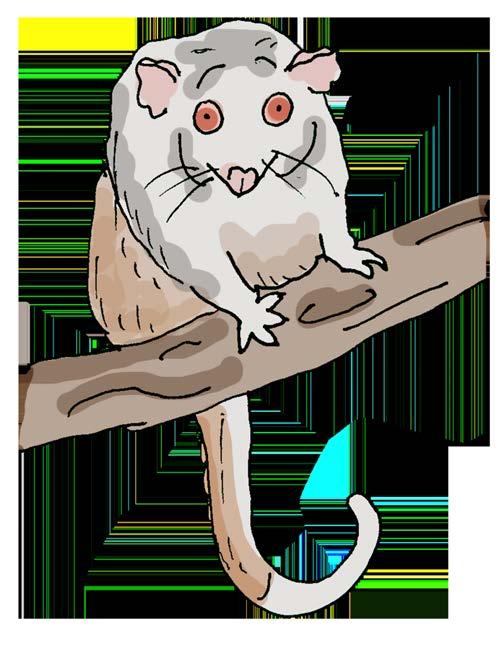
to live in either tree hollows (in the case of brushtails) or a nest-like drey (in the case of ringtails).
If you search ‘possum removal service’, the vitriol the average Sydneysider holds towards our possum population is regrettably clear. Pest removal services with various violent business names (the words ‘kill’, ‘dead’, ‘control’ and ‘busters’ appeared frequently in my casual search) offer possum removal and relocation to desperate clients.
attempt to close whatever entry point the animals were using to enter. Yet the FAQ sections of their websites are littered with questions about whether the animals can be killed or taken outside of their territory. Attitudes towards possums are at best resentful and frequently outright possum-cidal.
This is foolish — it’s ultimately not that hard to seal your roof (and a good idea, possums aside). A piece of fruit here and there, a thump on the roof every now and then, is a small price to pay for living in a place with such rampant biodiversity.
Genuine relocation of possums is extremely inhumane, as they are territorial animals that are unlikely to survive a move, so federal law prohibits moving the animals from the property on which they were captured. Instead, possum removal services largely just take possums out of people’s roofs and
What’s more, possums don’t end up in our roofs for no reason. The decline of mature, hollowbearing trees is driving possums to find shelter elsewhere. Protecting mature trees where we can, creating new forest habitat for the creatures, and providing artificial nesting boxes where needed are far more sympathetic ways to keep possums out of our roofs. Relocation is not enough — we need habitat.
ART BY ELLIE STEPHENSON
ENVIRONMENT | 23HONI SOIT WEEK TWELVE 2022
Maxim Adams on rediscovering a cockroach population last seen more than 80 years ago.
"The rediscovery of the roach is poignant in its timing."
Leave the possums alone!
Ellie Stephenson finds a nice tree hollow.
"Attitudes towards possums are at best resentful and frequently outright possum-cidal."
PresidentLauren Lancaster.
Good morrow denizens of USyd. There is something I find inexplicably irritating about that word, but I’ve never really used it and am in the habit of trying new things, so there you go.
With the impending transfer of power so near I can almost taste it, I am pleased to be writing this report postRepresentatives Elect. On Wednesday evening we elected all the new officers for the 95th SRC. As per usual it was a somewhat unhinged affair, made moreso by a bumpy return to in-person balloting for all positions. However, we concluded just after midnight and I congratulate most of the newly elected OBs (bar the right). I am willing to concede that the Regulations we changed this year will require another revision under Lia’s presidency, but that’s a job for the incoming Chair of Standing Legal and their Committee (which does, in fact, include me). I’ll be on the standing legal committee next year, but not much else.
In other news, we had a number of meetings this week about the website (chose a fun, photo-based, graphic template for the design foundation, and together with the QuAC convenors advised on the pronouns to be made available for student accounts), and academic integrity (less fun?, but quite important - ensuring that students don’t carry the can for minor breaches of academic integrity and that the Uni doesn’t require them to snitch on each other for sharing notes or similar - which was previously in the draft).
We also alerted Honi to reversion changes to the enforcement of the ESOS Act announced by TEQSA last week, which will require all Universities to return to fully in-person teaching arrangements for international students by June next year. You can read their coverage in this edition for more info. We will advocate for appropriate and non-punitive provisions for those unable to get to campus and for more effective communication from the uni to students as the situation develops.
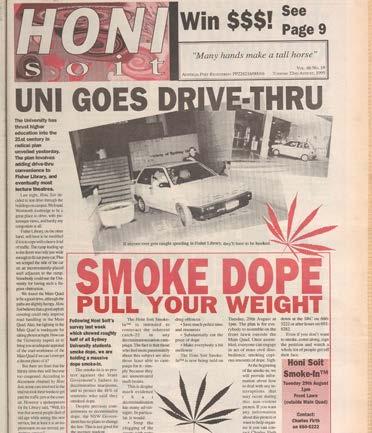
This week we will wrap up our base application for SSAF, and continue the handover to the new executive. I’m going to try take a little time off to study for finals. In that time, Lia will be acting President.
Next week will be my final report! I’ve got to think of how hilarious and novel I can be. Any ideas you can find me in the office or shoot me an email. It’s been a pleasure everyone, thanks for keeping me on my toes (and in my own head). See you around?
Lauren
Vice President

Emily Storey.
Time flies when you’re having fun - Foodhub has now helped 1753 students this semester!
If you ever doubt the value of Foodhub I encourage you to spend even just 10 minutes of your time sitting in there with us, because every day dozens of students tell us first hand how much we’ve changed their lives. Re-designing and running foodhub is truly the best thing i’ve ever done, and i can’t thank my volunteers enough for their help.
To those who voiced their concerns with the funding of Foodhub at Reps Elec, I want to say that I agree with you. I agree that Foodhub should be funded through uni management, it would come straight out of Mark Scott’s salary if it were up to me. Though that’s something I encourage the next exec to fight for, it would require the kind of reform that takes years to achieve. Fighting for long-term reform at USYD is crucial, but it doesn’t change the fact that the students we represent need our help NOW. Quite frankly I don’t think there’s a single better use of SSAF fees than preventing starvation in our community in the meantime.
I’ve spent time this week making a mother doc with all the contacts and tips the next exec needs to keep this service thriving in 2023. Huge congratulations to our new vice presidents Rose and Daniel - I have complete faith that the 95th src is in great hands.
Disclaimer (don’t sue us)
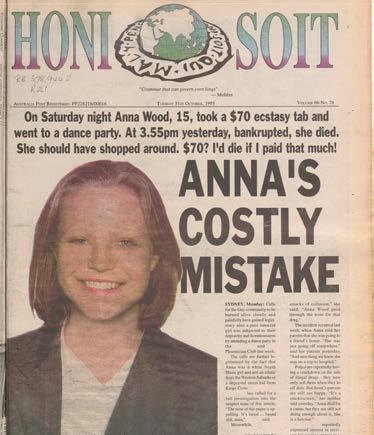
Hate what’s written on this page? Can’t blame Honi! The SRC Reports are by our elected Officer Bearers, and don’t get one lick of an edit by us. More info on these people at srcusyd.net.au/student-office-bearers.



General Secretaries
Alana Ramshaw and Grace Lagan.
As bittersweet as it is to be writing our 13th and final report, we’re quite simply grateful to have been given the honour of writing them. We’re thankful for every office bearer, every councillor, every factional operator, and every hanger-on that has made this year what it is. While we know OB reports tend to go unread by most Honi readers, we’ve had a lot of fun this year writing ours (noting we haven’t missed one! not one!), and we’re truly very grateful to anyone who has taken the time to indulge us and our lukewarm bits.
This year has gone by faster than either of us could have anticipated, but we couldn’t be prouder of everything we’ve done this year, from standing with staff on the picket lines, to FoodHub and Rad Ed, to securing a fighting, left-wing student union for another year.
Student politics is often derided by many as an extracurricular for egomaniacs, and we frankly don’t entirely disagree with such an analysis. However, we also argue that the SRC, an organisation that for decades has stood against injustice and defended the rights of students, will always be a categorically worthwhile project.
For every callous hack, there is an OB who stays up late, ingesting black mould in the SRC offices to meticulously plan the next rally, stall, or service. For every devastating blow the government, business, or university management delivers to us, there are so many other successes to be proud of. We kicked out the liberals, we stopped the Religious Discrimination Bill, we won a closer-to-poverty-line wage for student journalists, and campus is more vibrant than ever as we near the fourth year of a global pandemic.
As the Amadeus quote goes, “Goodness is nothing in the furnace of art, but everything that student unionism can and should be.” And god, we’re good.
For the last time, Lani and Grace
Disabilities Officers
We are excited to welcome Khanh Tran and Jack Scanlan as the new Disabilities Officers for 2023. We have a busy week ahead with a social this Wednesday to celebrate the launch of Disabled Honi and a Rad Ed talk.
Welfare Officers
Welfare Action Group meetings will be running until the end of Semester 2. Please look out for our Week 12 meeting, which we will be releasing details for soon. We always welcome new members, so please come along if you would like to get involved in advocating for welfare justice.
The Welfare Officers have been working to set up the Welfare Action Group and SRC Welfare Department for next year. Recently, we preselected our WAG convenors for 2023. We extend our congratulations to Jack Scanlan, Eleanor Douglas and Harrison Brennan on their preselections. We are very confident in their ability to advance the interests of student and community welfare in the year ahead as WAG convenors. We also congratulate the new 2023 Welfare Officers recently elected at RepsElect.
Furthermore, we have been continuing to support the SRC and USU’s Foodhub initiative, have been working on our initiative fighting for the removal of the University’s 6-session limit on its Counselling and Psychological Services (CAPS) service, working to respond to the government’s recent removal of COVID case isolation requirements which will put disabled and immunocompromised people at the University and in our communities at risk and supporting the work of DisCo and the SRC Disabilities Officers in ensuring the University’s new 5-day extension system is accessible to students with due date adjustments under their academic plans. We have also been involved in giving comment to Honi Soit reporters regarding issues of student welfare on several articles.
We hope all students keep safe and healthy during the exam period, and extend our appreciation to everyone who has supported the SRC Welfare Department throughout 2022.
Ethnocultural Officers
Misbah Ansari, Ashrika Paruthi and Anya Doan.
The Autonomous Against Racism has been supporting staff strikes on campus in recent weeks. Last week we held a meeting to discuss ideas for next year, and we are so honoured to have the newly elected 2023 conveners take over!
HONI SOIT WEEK TWELVE 202224 | SRC
Grace Wallman, Eamonn Murphy, Jason Zhang, and Yasmin Johnson.
Sarah Korte, Ira Patole and Holly Haoyi Zhang.
Online learning gave us online exams, which have been invigilated by programs such as ProctorU. Here are some tips for you to consider.

Tips on avoiding plagiarism during ProctorU exams:
Students can get into trouble if they breach the rules of exams, so be sure to read the rules carefully before your exam starts. Some ProctorU exams aren’t invigilated live, only recorded and later reviewed, so because they are not real time invigilated exams, you won’t be warned at the start of the exam as you would for in-person invigilated exams about some of the potential breaches.
Preparing your Computer
May sure to check your computer settings at least a few days before your exam, that includes checking your camera, and audio settings are set up correctly and appropriately for your online exam. During the exam make sure you close all other windows and applications on the device you are using for that exam as well as any other device (laptop, tablet, mobile phone, etc). If you are doing your exam overseas and your exam is scheduled for between 10pm and 6:59am your local time, you may be eligible for special arrangements.
If you have technical difficulties during an exam, you should apply for special consideration as soon as your exam is finished. Try to get evidence of the issue to submit with your application, you should also notify your Unit Coordinator as soon as possible.
It is better to avoid technical problems as special consideration may not be approved. It is important that you apply for special consideration within 3 working days if you experience illness or misadventure with documentation that covers that dates you were affected. If you cannot apply within the 3 working

days, please contact the SRC for advice as soon as possible

Exam materials not permitted:
You are not allowed to wear wired or unwired headphones during your online exams. If you need quiet for the exam you can wear foam earplugs, or go to a library or another quiet location where you can focus. You may not be allowed to look at your phone or look away from the computer screen during the exam. If you are seen to be looking around, the Uni will want to know what you are looking at. You will be advised in writing prior to exam if there are any materials you are allowed to access during the exam, including formula sheets. ProctorU will detect if you access any other online resources during the exam.
Movement during exams:
The ProctorU mechanism may not be able to differentiate between regular nervous movement and legitimate cheating. For example, if a student was looking at a clock off from their screen, then that may be identified as suspicious, it is at the instructor’s full discretion to address ‘suspicious’ behaviour. If possible, avoid anything that might be considered suspicious.

Appealing:
The process of appeal can be lengthy for issues of a technical nature, so check your equipment well ahead of the exam and notify the faculty of any problems then. Please contact the SRC for advice

Alternative to ProctorU:
There are some limited spaces available for in person exams on campus. If this would be a better option for you, talk to your subject coordinator or an SRC caseworker help@src.usyd.edu.au or call 9660 5222
Ask AbeAsk Abe
SRC caseworker help Q&A



Special Consideration

Hi Abe,
I’ve been accused of changing the medical certificate I used for special consideration for an assignment. I don’t know why they are accusing me of this. I saw the doctor and he said I had to pay a fee, but he was a real doctor. What should I do?
Genuinely Sick
Hi Genuinely Sick,
Providing a fake medical certificate is considered a very serious matter by the University. Usually, they phone the doctor to check if a certificate is fake or real. If the University has made this mistake with your certificate you should talk to a caseworker about what your options are. If you have used a fake medical certificate it is always best to admit to your wrongdoing, and explain the circumstances that caused you to do this. Again, talk to a caseworker about how to respond to the Uni.
Abe
For more information & links see: srcusyd.net.au/src-help/academic-issues/ special-consideration
SRC CASEWORKER HELP | 25HONI SOIT WEEK TWELVE 2022
Students’ Representative Council, University of Sydney e: help @ src.usyd.edu.au | w: srcusyd.net.au usydsrc src_usyd src_sydneyuni Do you need to apply for Special Consideration for illness, misadventure or disability? SRC caseworkers can provide advice on applying for Special Consideration & appealing rejected applications. help@src.usyd.edu.au | 02 9660 5222 | srcusyd.net.au For more information & links see: sydney.edu.au/students/exams.html Preparing for online exams – Tips for using Proctor U
Across Down Quick Crossword
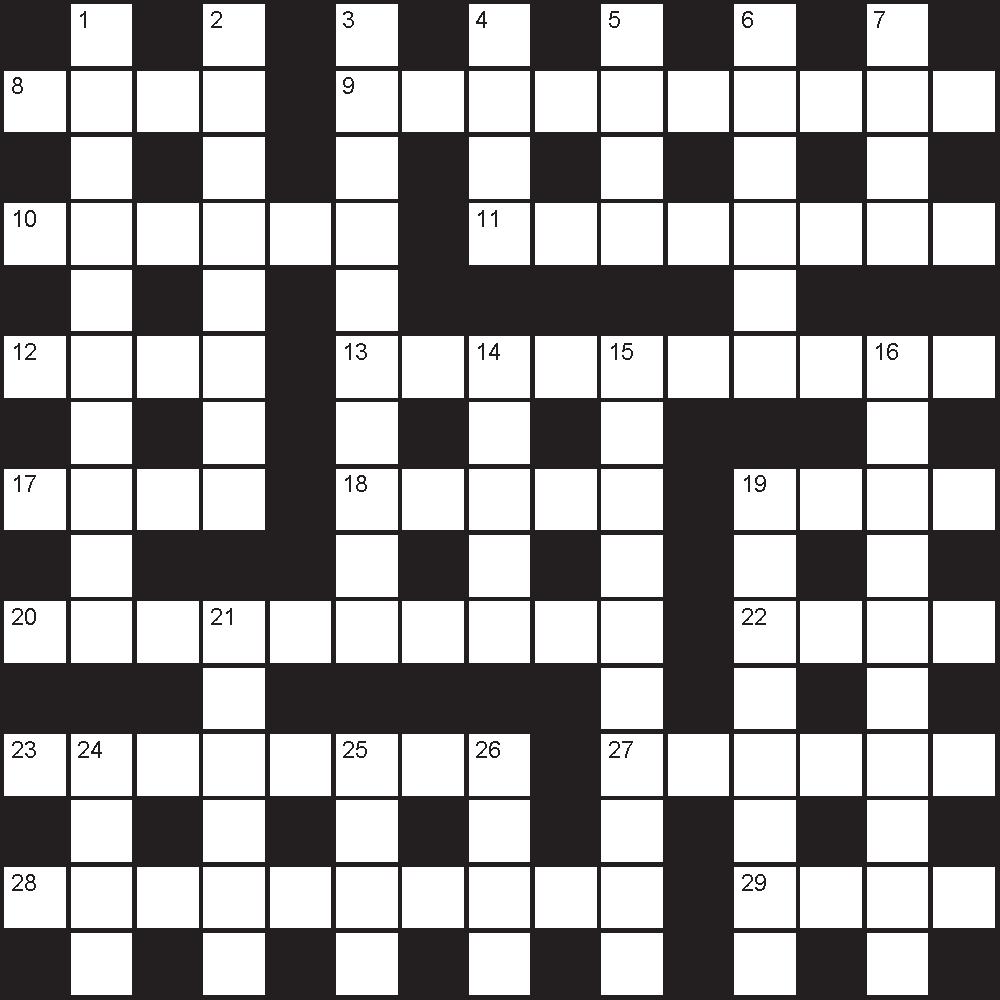

8. Animal featured in documentary Blackfish (4)
Feature of Play School (4,6)
Region of flat grassland, such as found in central Asia (6)
One who pulls rabbits from hats (8)
Paramedic (4)
Movie starring Jane Fonda, Lily Tomlin, and Dolly Parton (4,2,4)
Immediately, pronto (4)
Avian emblem of the U.S.A. (5)
Make whoopee (4)
These are by the sea at the moment (10)
Innards (4)
Latin prayer, famously set to music by Schubert (3,5)
Opposite of a bargain, rort (3-3)
Late one doing an assignment at Fisher,
(3-7)
An area of the lower back or upper legs, apt
be girded (4)
Across Down
8. Champion among the Romans (4)
9. Where the cloth might go is up for discussion (2,3,5)
10. Quick saucerecipe beginning within (6)
11. Female leader reportedly casuses trouble (8)
12. Rechoreograph section of counterpart (4)
13. Partly overheard surrealist ate houses (4,6)
17. Letters for when people are getting here (4)
18. Cockney collector establishes system (5)
19. Went online to speak with worker (4)
20. Country to hit 80% of ladies with bomb (10)
22. Express regret for gravy base (4)
23. Merged an organisation to find copper in France (8)

27. Oregon embraces live musical performance (6)
28. Bizarre bosom trick usingmagical implement (10)
29. Everyone is in the heart of treachery (4)
1. The third ‘R’ of children’s education (10)
2. Narnian landmark (8)
3. Body in charge of a country (10)
4. Soothing ointment (4)
5. Gulp (4)
6. Charity for children (6)
7. Couch (4)
14. West African country (5)
15. Those in charge of money within a 3 Down (10)
16. Victorian novel or contemporary American magazine (6,4)
19. New York, colloquially (3,5)
21. Dirge (6)
24. Terribly evil! (4)
25. Latvian capital (4)
26. ‘High’ singing range (4)
Quiz
1. Which Canadian psychologist is associated with lobsters, an all meat diet, and a crippling benzo addiction that put him in a coma?
2. Who was recently sworn in as prime minister of Italy?
3. Which American socialite is best known for her relationships with Tyga and Robert Kardashian?
4. Which Australian sportsman who found success in rugby league, union, and AFL now plays for the Urayasu D-Rocks in Japan?
5. Which actor had his breakout role in Boyz n the Hood before winning the Best Supporting Actor Oscar for Jerry Maguire?
6. Find the connection between these people.
Answers
no further! Succour ends with
(10)
team about to receive discipline (4)
in all directions (4)
loudly, holding bag (6)
excitement (4)
fur lost carelessly in fog (5)
she assembled on ancient mounds
blunter cue for roughness (10)
Head science teacher holds filtration device (8)
Shaky oral on hotel room companion (6)
speaker in beige (4)
Reckless breakout (4)
Terribly vile! (4)
HONI SOIT WEEK TWELVE 202226 | PUZZLES
honisoit.com/puzzle-answers
9.
10.
11.
12.
13.
17.
18.
19.
20.
22.
23.
27.
28.
perhaps
29.
to
Puzzles by Tournesol Quiz by Cloud Runner Cryptic Crossword 1. What makes a warrior? Reportedly: fear and a place to sleep, thanks (5,5) 2. Grain or loud animal (8) 3. Go
tool giving a disease
4. Baseball
5. Gossip
6. Saunter
7. Show
14. Dreadful
15. Artwork
(10) 16. Fashioned
19.
21.
24. Acquire
25.
26.
The End TimesThe End Times

Doomed Irish unity
Fruit
AI generators
drinks
Inspired by a spate of passionate articles by the Sydney Morning Herald about the urban planning disaster that is the Barangaroo development, Sydney City Mayoress Zoner Bore has proposed a substantial change to Sydney’s skyline. Realising that the core of most commentary on the area lies in the remarkably penile nature of the suburb’s centrepiece, the Barangaroo Tower, Ms Bore suggested offsetting the offending landmark with a new, larger skyscraper entitled Yoni.
Bore told The End Times: “The Barangaroo tower has been too phallic for too long. The energy of the area is just off. I want to change our cityscape to better reflect the diverse interests of my constituents!”
The new construction will feature a particularly clitoral sky-deck at 900m, making it both the tallest clitoral sky-deck in the world, and also the tallest building. Early feedback has expressed concerns that certain patrons may struggle to locate the feature.
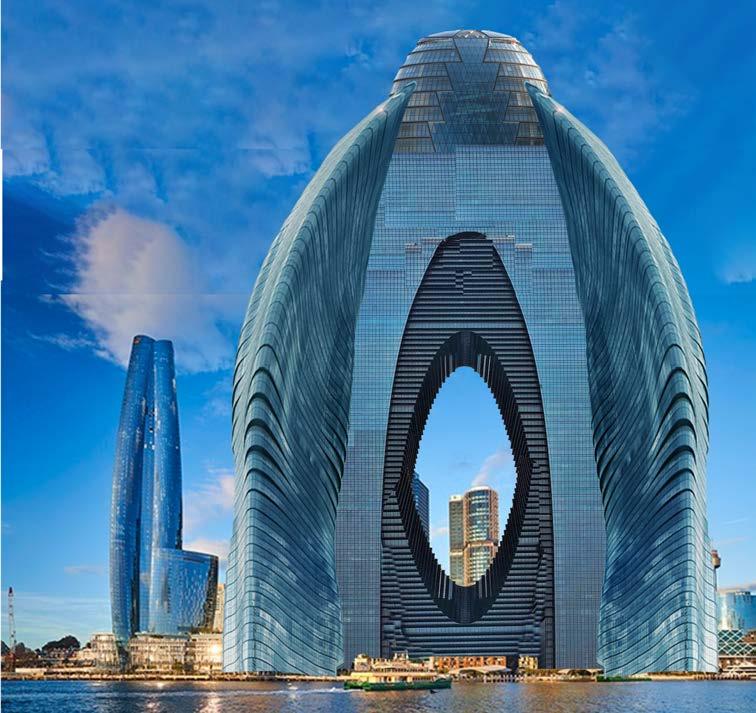
Some advocates have taken aim at the absence of pubic hair from the monument.
“Along with being nearly a kilometre tall, it’s just another unrealistic expectation for those among us with vaginas to live up to,” Glebe foreshore resident Jen Triffiah commented on the development application.
West Berlin Diet
Pub
IN THIS ISSUE:
My pubes do NOT taste like Fanta
- Ran Gah
Not making my bed is a radical rejection of heteronormative bedroom practices
- Ladeee Witchee
Stalin was FUCKED! Anyways, up the Western Imperial system
- Viro, En
I love secrets so much, I’m going to tell you all about it!
- Shh
I’m not a dyke, can I still edit Honi Soit?
- Threat Enned
REDEEM AT HONI SOIT
CHANCE
BRITISH PM SPOT
CLOWN CARCRASH CHAOS
GETS ELECTED
The University of Sydney’s Queer Action Collective has announced their upcoming campaign, which will target Artificial Intelligence (AI) art generators.
The generators work by the user inputting words or phrases, then the AI bot presenting random, often frightening, bordering on vile images for the user.
Recently, online users have complained that the bots censor words associated with queer
cultures and behaviours.
“I ‘entered gremlin femme WLW cottagecore fairy mushroom polyamorous ethical pav energy virgo sun pisces moon spoopy pagan bisexual cowboy erasure normalise representation doggo feeling seen valid babe creative tarot dental dams caribener introverted extrovert radical honesty accountability veggie patch witchcraft reclaimed warehouse’ into the generator, and it said those words were denied! That’s #FUCKED!”
COMEDY | 27HONI SOIT WEEK TWELVE 2022
:/
Green
SMH
Coke
Destined Rishi Vagina Cricket Orange
ABC
East Berlin Pepsi Max
Bar
Incoherent. Always. EXCLUSIVE...Hear from Queer Housing Sydney survivor...“It Was Sticky!” Wed October 26 Vol. 420 + 25 Cheaper and more available than toilet paper! The only newspaper. Proudly Murdoch. Pro-News. Anti-Truth. People’s Republic of USyd. $4.20
OFFICE FOR
AT
QUEER ACTION COLLECTIVE TO LAUNCH CAMPAIGN AGAINST AI GENERATORS, CLAIM “CHRONIC CENSORSHIP” ARCHITECTS CALL FOR GIANT VULVIC CASINO TO OFFSET HORROR OF CROWN’S BARANGAROO TOWER FIRST YEAR LIBERAL LAW STUDENT
AS SRC’S ENVIRONMENT OFFICE BEARER (THIS IS LEGIT #NOT A JOKE) GRASSROOTS TO IMPLEMENT POLITICS CHECK FOLLOWING SECOND STALINIST INCIDENT IN A ROW (#A JOKE)
CHRONIC CANDIDATE CATCHES CASE OF CON CLUB COMMANDER, CAUSES



NOW HIRING: DETENTION CENTRE SECURITY OFFICERS. RACISTS AND RAPISTS WANTED. AUSTRALIAN BORDER FORCE Smuggle drugs through here Security camera blindspots (assault detainees here) Suicide hotspot (stay away unless you want paperwork) Hunger strikes will happen here Abuse power to sleep with detainees here Main entrance (no phones or journalists allowed) Paid for by the Australian Government, Canberra.



















 Nicola Brayan logs on.
Nicola Brayan logs on.











































